
Saving A British Bailey Bridge
Last Vestige of the Battle of Normandy in the Bocage
 Version Française
Version Française
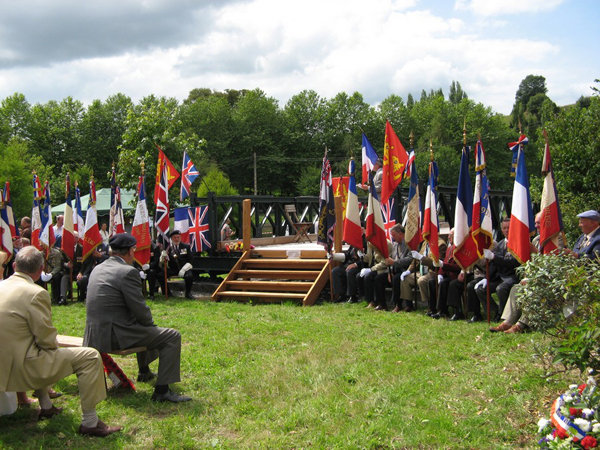
See Bailey Bridge Appeal - Those who have helped us
See full list of members of Les Amis du Pont Bailey
Arromanches Mulberry Harbour and the Pont-Farcy Bailey Bridge
See images of the Arromanches Mulberry 'B' harbour and Bailey bridges in Normandy
'Saving A Bailey Bridge': see images from an illustrated talk by Christopher Long in 2015
This Bailey bridge was about to be destroyed... but has been saved for posterity...
O
n 9 June 2008 a huge crane hoisted a 25 tonne Bailey Bridge from its position straddling the river Vire in Basse-Normandie, France. Within a few minutes the 27 metre long bridge had been dumped onto the river bank awaiting men to cut it up and sell it off as scrap. Since at least 1958 this historic veteran of World War ll had served the tiny commune of Fourneaux, but was now no longer wanted.
Made in England in the 1940s, this bridge served an important role during the Battle of Normandy in 1944. It had crossed the English Channel in the days following D-Day to form a vital part of the Arromanches artificial harbour (Mulberry 'B'). There, from June to November 1944, it bridged an obstacle between the articial harbour causeways and the strategic coastal road. Between 5,000 and 10,000 tons of British military materiel passed through the harbour every day, crossing this and other Bailey bridges like it throughout Normandy. In 1958 our bridge was moved from Arromanches to be reassembled about 60 miles inland where, for 60 years, it bridged the river Vire between Pont-Farcy and Fourneaux, replacing a small metallic lock-keeper's bridge destroyed by the Germans in 1944.
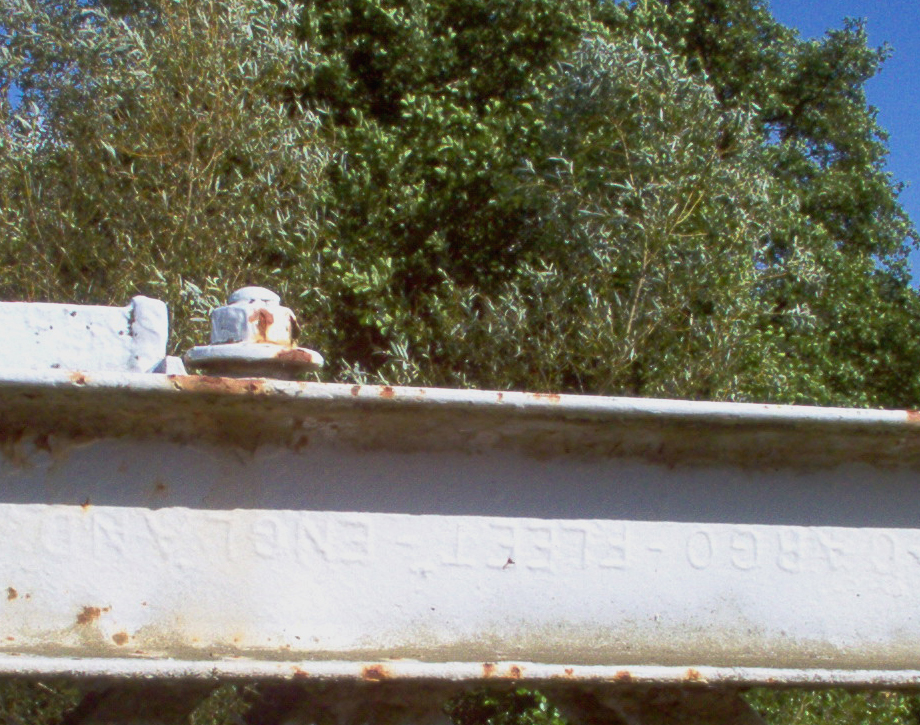 Sadly, by 2008, no one in the area seemed to remember that they had a neglected historic monument in their midst. As far as the local authorities were concerned, this was just an old iron bridge that needed to be replaced. [The same local community (Pont-Farcy) had already allowed another WWll Bailey bridge at La Grippe to be scrapped unceremoniously in 2002, as well as allowing an equally historic single 'Whale' element of a Mulberry harbour causeway from the artificial harbour at Arromanches (Mulberry 'B') to be lost in 1990! By 2012, however, the 'lost' Whale had been located and had been lent by Les Amis du Pont Bailey to a museum not far from Carentan.]
Sadly, by 2008, no one in the area seemed to remember that they had a neglected historic monument in their midst. As far as the local authorities were concerned, this was just an old iron bridge that needed to be replaced. [The same local community (Pont-Farcy) had already allowed another WWll Bailey bridge at La Grippe to be scrapped unceremoniously in 2002, as well as allowing an equally historic single 'Whale' element of a Mulberry harbour causeway from the artificial harbour at Arromanches (Mulberry 'B') to be lost in 1990! By 2012, however, the 'lost' Whale had been located and had been lent by Les Amis du Pont Bailey to a museum not far from Carentan.]
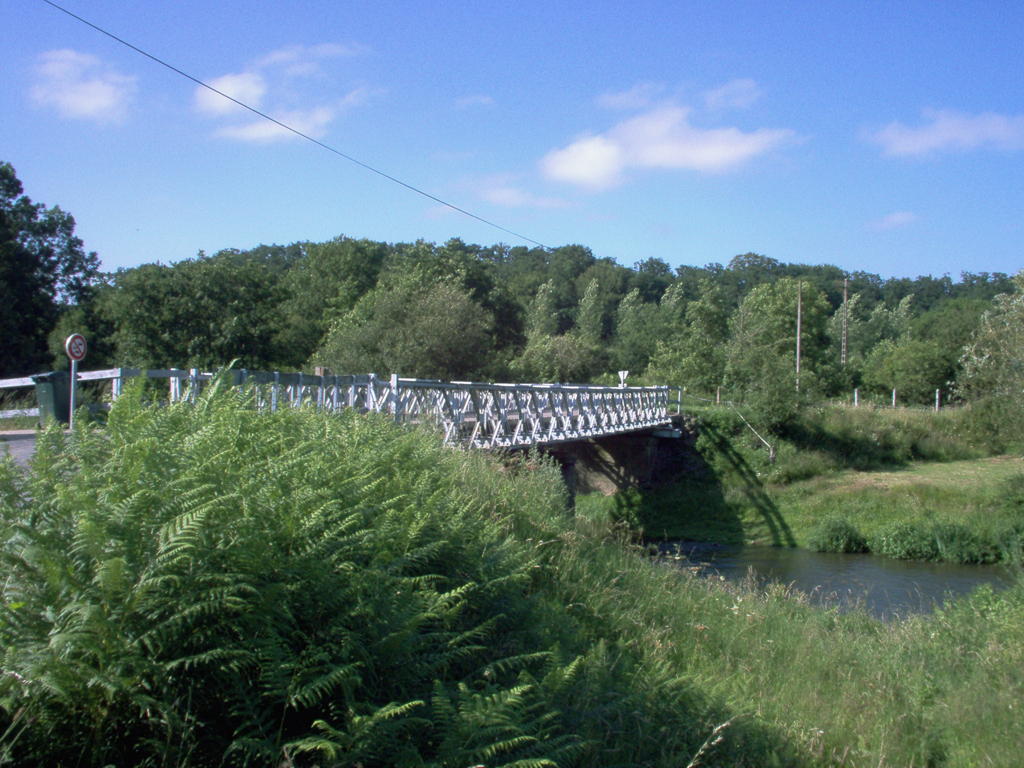 Fortunately, the author had studied the Bailey bridge at Fourneaux a couple of years earlier [see images right]. On many sections of this Bailey bridge were the names of its makers, Dorman Long of Cargo Fleet or British Steel and England, etc., along with dates such as 1942 and 1944. Its original grey paintwork (marine camouflage) marks it out as part of the Arromanches Mulberry 'B' Harbour in 1944 where it was indeed located in 1957.
Fortunately, the author had studied the Bailey bridge at Fourneaux a couple of years earlier [see images right]. On many sections of this Bailey bridge were the names of its makers, Dorman Long of Cargo Fleet or British Steel and England, etc., along with dates such as 1942 and 1944. Its original grey paintwork (marine camouflage) marks it out as part of the Arromanches Mulberry 'B' Harbour in 1944 where it was indeed located in 1957.
 The day after this wonderful bridge had been dumped unceremoniously on the banks of the river Vire, the author decided to do what he could to save it. On 17 June, with the invaluable help of his good friend Georges de Coupigny, president of the AVPPS, a campaign was mounted, with just days to spare. Suddenly we had generous support from a wide range of people, including local historians, ex-combatants and members of the regional press and local radio.
The day after this wonderful bridge had been dumped unceremoniously on the banks of the river Vire, the author decided to do what he could to save it. On 17 June, with the invaluable help of his good friend Georges de Coupigny, president of the AVPPS, a campaign was mounted, with just days to spare. Suddenly we had generous support from a wide range of people, including local historians, ex-combatants and members of the regional press and local radio.
 On 23 June 2008, at a meeting on the bridge with Jean-Paul Daval of the DDE (responsible for dismantling the old bridge and building its replacement) it was accepted that this was indeed a genuine wartime Bailey bridge. The DDE imposed a moratorium to give us time to find a way of preserving an historic monument.
On 23 June 2008, at a meeting on the bridge with Jean-Paul Daval of the DDE (responsible for dismantling the old bridge and building its replacement) it was accepted that this was indeed a genuine wartime Bailey bridge. The DDE imposed a moratorium to give us time to find a way of preserving an historic monument.
This moratorium was confirmed on 4 July 2008 by DDE director Jacques Le Berre in a letter to Jean-Yves Cousin, the local Calvados député (member of parliament). In it he said that the construction company Entreprise Torres et Vilault had been ordered not to destroy or remove the bridge until a decision on its future had been made, hopefully by mid September.
 See the WWll Bailey bridge at Fourneaux soon after it had been removed and unceremoniously 'dumped' beside the river Vire in June 2008. This is what we wanted to preserve... It may not look beautiful here but it did when it was first built. It played a key role twice in 1944 (on the British D-Day landing beaches and then in the Battle of Normandy) and contributed to peace in Europe in 1945. We hoped that this rather wonderful piece of British army engineering would regain its elegance, as a lasting memorial to the Royal Engineers who first laid it, and to all Allied forces who then used it to liberate France and Western Europe in 1944-45.
See the WWll Bailey bridge at Fourneaux soon after it had been removed and unceremoniously 'dumped' beside the river Vire in June 2008. This is what we wanted to preserve... It may not look beautiful here but it did when it was first built. It played a key role twice in 1944 (on the British D-Day landing beaches and then in the Battle of Normandy) and contributed to peace in Europe in 1945. We hoped that this rather wonderful piece of British army engineering would regain its elegance, as a lasting memorial to the Royal Engineers who first laid it, and to all Allied forces who then used it to liberate France and Western Europe in 1944-45.
Our aim...
Our aim was quite simple. We wanted to preserve and conserve this bridge for posterity. It is the last physical evidence in the Bocage Virois of one of the greatest battles of all time during the greatest war of all time.
Very quickly we set up a non-profit-making association in France called Les Amis du Pont Bailey.
First we needed to dismantle it and strip off loose old lead paint. Then, when it had been restored and repainted, we needed to find a location where it could be reassembled to be freely seen and appreciated by everyone. Thanks to the DDE(50) we were given the bridge. Thanks to the Conseil Général we were granted a perfect location with easy access. And thanks to the Royal Engineers and our hundreds of members and volunteer helpers, the work was done without needing to ask for one penny from public funds.
Well-located (slightly raised on level ground) it can now serve the whole community as a stage for village events, memorial services, concerts, firework displays and open-air parties and gatherings of all sorts.
Without this bridge, what would we in Normandy have been able to show our children and grandchildren of the huge sacrifice made in the hedgerows and sunken lanes of the Norman Bocage in the summer of 1944? This bridge symbolises the colossal effort, sacrifice and loss of life suffered by British, American and Canadian troops. It is also a vital memorial to the history of the Liberation of France and of Europe.
Background notes...
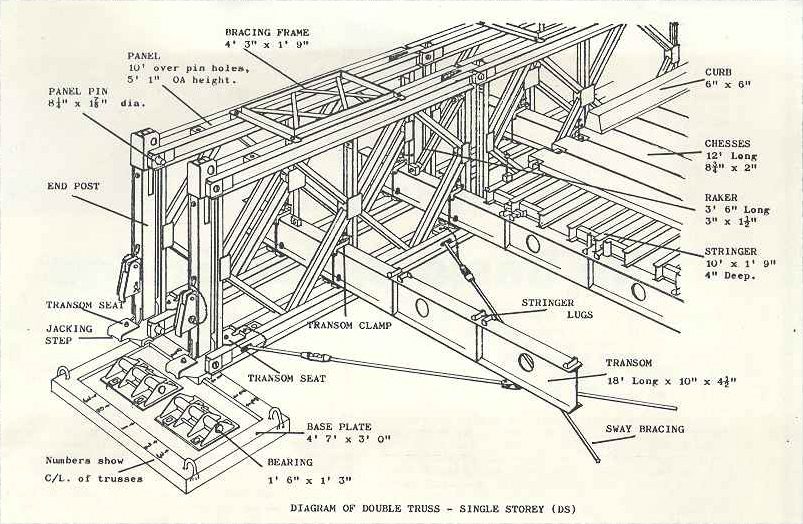 1. Bailey bridges are composed of simple and standard elements which can be easily and quickly assembled or dismantled for reuse elsewhere. A team of 8 sappers led by an officer and a couple of NCOs were easily capable of launching a fixed-span bridge of nine sections in three or four hours. It was not uncommon for 8-16 men to build three bridges in a day – the parts all being supplied from light lorries. Fixed-span bridges would usually be launched by building a length rather longer than twice the finished span needed, then pushing the entire length across the river or gap with a lorry or tank. The leading section (or nose) would be slightly raised to allow the span to slide over the far side. The excess length would then be dismantled. Floating pontoon bridges, or those designed to rise and fall with the tide, usually incorporated Bailey elements and required more skilled design and construction capabilities.
1. Bailey bridges are composed of simple and standard elements which can be easily and quickly assembled or dismantled for reuse elsewhere. A team of 8 sappers led by an officer and a couple of NCOs were easily capable of launching a fixed-span bridge of nine sections in three or four hours. It was not uncommon for 8-16 men to build three bridges in a day – the parts all being supplied from light lorries. Fixed-span bridges would usually be launched by building a length rather longer than twice the finished span needed, then pushing the entire length across the river or gap with a lorry or tank. The leading section (or nose) would be slightly raised to allow the span to slide over the far side. The excess length would then be dismantled. Floating pontoon bridges, or those designed to rise and fall with the tide, usually incorporated Bailey elements and required more skilled design and construction capabilities.
 2. Some parts carry the inscription of the makers: 'Dorman-Long', 'British Steel', 'Cargo Fleet', etc. However, the entire structure of our bridge did not appear to have been painted in any other colour than its original camouflage grey (associated with the Mulberry harbours) and older inhabitants of Fourneaux remember the regional councillor of the time "going to Arromanches to find a bridge for Fourneaux in 1957 or 1958".
2. Some parts carry the inscription of the makers: 'Dorman-Long', 'British Steel', 'Cargo Fleet', etc. However, the entire structure of our bridge did not appear to have been painted in any other colour than its original camouflage grey (associated with the Mulberry harbours) and older inhabitants of Fourneaux remember the regional councillor of the time "going to Arromanches to find a bridge for Fourneaux in 1957 or 1958".
3. At least two other Bailey bridges have survived in Basse-Normandie:

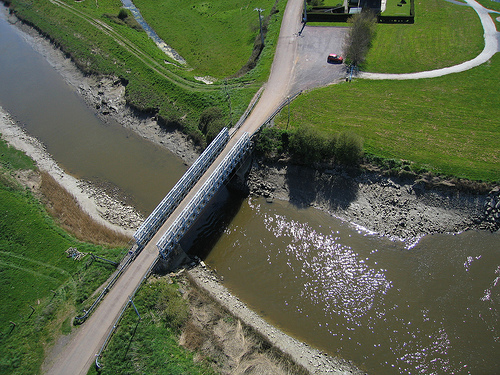 One is the double-double Bailey bridge on the Taute/Vire Canal near Carentan in Manche, which was still in use as a road bridge in 2008.
One is the double-double Bailey bridge on the Taute/Vire Canal near Carentan in Manche, which was still in use as a road bridge in 2008.
The bird's eye view of the Carentan bridge (right) is an aerial photograph by Nigel Shaw (©) using a camera lifted by a kite.
It was built in 1944 to allow American tanks to break out from Carentan and to cross the Taute/Vire canal on their way towards St Lô.

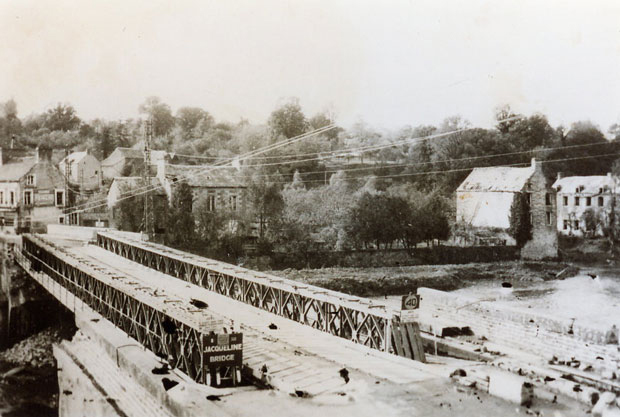 The other is the 'Jacqueline' Bailey bridge which was built by British Royal Engineers across the river Orne at Pont-d'Ouilly.
The other is the 'Jacqueline' Bailey bridge which was built by British Royal Engineers across the river Orne at Pont-d'Ouilly.
Later this triple-single Bailey bridge was moved not far away to cross the Noireau before being bought by Michel Leloup for his 'Musée Août 1944' in Falaise.
4. Note also that the end posts on the newly re-assembled bridge at Pont-Farcy are Mkll elements attached to an original 'Mkl' bridge (though it was never described as Mkl). This was the standard during WWll and almost all such Bailey bridges will be found to have Mkll end-posts.
5. For fascinating images of Bailey bridges throughout the world from the Second World War onwards, see this excellent site by Patrick Claeys.
6. No article concerning Bailey bridges is complete without mention of Sir Donald Bailey, its British inventor. I'm grateful to Wikipedia for the following exerpts:
 "... The Bailey bridge is a portable pre-fabricated truss bridge, designed for use by military engineering units to bridge up to 60 m (200 foot) gaps. It requires no special tools or heavy equipment for construction, the bridge elements are small enough to be carried in trucks, and the bridge is strong enough to carry tanks. It is considered a great example of military engineering..."
"... The Bailey bridge is a portable pre-fabricated truss bridge, designed for use by military engineering units to bridge up to 60 m (200 foot) gaps. It requires no special tools or heavy equipment for construction, the bridge elements are small enough to be carried in trucks, and the bridge is strong enough to carry tanks. It is considered a great example of military engineering..."
"... Each section weighs just under 2 tonnes (more than 2 tonnes when its timber chessess and ribands are included). A typical Bailey bridge in Normandy consisted of nine sections (about 20 tonnes in total)...."
"... Donald Bailey was a civil servant in the British War Office who tinkered with model bridges as a hobby. He presented one such model to his chiefs, who saw some merit in the design and had construction started at a slow rate. The bridge was taken into service by the Corps of Royal Engineers and first used in Italy in 1943.

 A large quantity of Bailey bridging was available by 1944 for D-Day, when production was ramped up. The US also licensed the design and started rapid construction for their own use. Bailey was later knighted for his invention, which continues to be widely produced and used today..."
A large quantity of Bailey bridging was available by 1944 for D-Day, when production was ramped up. The US also licensed the design and started rapid construction for their own use. Bailey was later knighted for his invention, which continues to be widely produced and used today..."
According to other sources: Donald Bailey developed his design from 1936-40, final design work starting in December 1940; it was tested in May 1941 and first deployed in North Africa in November 1942.
For an authoritative article on military bridge building, the Royal Engineers, Bailey bridges and their inventor, Sir Donald Bailey, see Military Bridging by the Royal Engineers Museum. See another fascinating article on the work of the Royal Engineers before, during and after D-Day.
Progress and support...
- In August 2019 the association organised a battlefield tour of the entire scope of Operation Bluecoat from Cautmont-L'Éventé to La Pavée on the Vire-Condé road. For this we were joined by John Evans and his family, John being the son of a Welsh Guards tank captain who took part in the actions. Also with us was our invaluable supporter, Paul Harris, whose grandfather, George Hanks, was killed at Estry during Operation Bluecoat, was temporarily buried at Estry and subsequently reburied with his comrades at the British war cemetery at nearby Saint-Charles de Percy. About 20 of us were kindly received by Michel Leteinturier, OBE, and his wife Jeanne for a vin d'honneur. Michel Leteinturier, local farmer, was honoured by the Queen for a lifetime's commitment to recording and publishing the Bluecoat events and for generously welcoming returning servicemen who had survived these lethal actions in 1944 that led to the liberation of Normandy, France and Western Europe.
- In 2016, 2017 and 2018, Pont-Farcy's Bailey Bridge was the centre-piece of the annual village 'fête'. Mainly used as a sound stage for rock bands and choirs, the bridge also provided a physical emblem of unification which was especially relevant as the communes of Pont-Farcy and Pleines-Oeuvres faced crises of identity and prepared to find themselves transferred, under local government reorganisation, from Calvados to Manche and from long-term local independence to a new identity as part of Tessy-Bocage.
 In 2016, thanks to the extraordinarily physical contributions of Rob Adams and Alen Dosen, our president was able to sandblast, strip and repaint the bridge. This was necessary because the paintwork done by the Royal Engineers in 2008 was inevitably rushed and done under a great deal of rain. Thanks to generous contributions from Paul Harris (whose grandfather was killed in the liberation of nearby Estry in August 1944) and from Guillaume Bourrel, of Landelles-et-Coupigny, we were able to finance the hire of compressors, sand-blasting equipment and paint sprayers. The paint itself was mixed to our own specification ('semi-matt olive drab') and supplied to us as another generous gift by PPG Industries (Johnson) in the UK.
In 2016, thanks to the extraordinarily physical contributions of Rob Adams and Alen Dosen, our president was able to sandblast, strip and repaint the bridge. This was necessary because the paintwork done by the Royal Engineers in 2008 was inevitably rushed and done under a great deal of rain. Thanks to generous contributions from Paul Harris (whose grandfather was killed in the liberation of nearby Estry in August 1944) and from Guillaume Bourrel, of Landelles-et-Coupigny, we were able to finance the hire of compressors, sand-blasting equipment and paint sprayers. The paint itself was mixed to our own specification ('semi-matt olive drab') and supplied to us as another generous gift by PPG Industries (Johnson) in the UK.
 We also owe a debt to committee member Bill Hollis who helped source the paint and to our current president, Simon de Lautour, who said quite simply: 'Well, if we have to do it, we have to do it! Let's just strip it and paint it and hope that people will rally round...'. Paul, Guillaume and PPG did indeed rally round, allowing Christopher Long and Rob Adams to concentrate on the physical work of conserving and preserving our bridge.
We also owe a debt to committee member Bill Hollis who helped source the paint and to our current president, Simon de Lautour, who said quite simply: 'Well, if we have to do it, we have to do it! Let's just strip it and paint it and hope that people will rally round...'. Paul, Guillaume and PPG did indeed rally round, allowing Christopher Long and Rob Adams to concentrate on the physical work of conserving and preserving our bridge.
 The Bailey Bridge annual picnic in 2014 is shared with the Pont-Farcy village fête, beside the river Vire, on 17-08-2014. Come and join us!
The Bailey Bridge annual picnic in 2014 is shared with the Pont-Farcy village fête, beside the river Vire, on 17-08-2014. Come and join us!
-

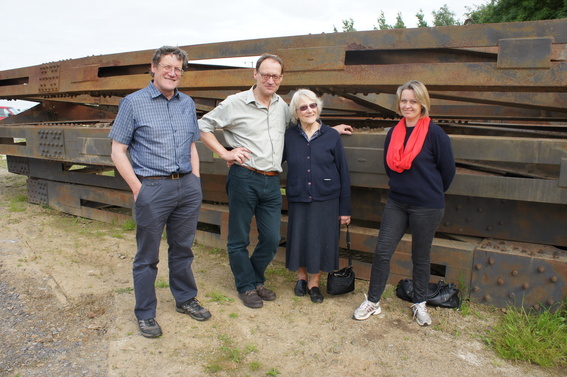 On 03-06-2014 The association was delighted to meet members of the Beckett family who came to Pont-Farcy to visit the Bailey Bridge and to stay on for lunch afterwards. Allan Beckett, MBE, (1914-2005) was the brilliant Royal Engineer designer of the 'Whale' bridging sections that formed the floating roadways of the 1944 Mulberry Harbours and who went on, as a civil engineer, was passionate about bridges and bridging. Les Amis du Pont Bailey were naturally delighted to meet at last Allan's widow, Ida, and his two sons Tim and Mike (along with Tim's wife and an old family friend, Major William 'Bill' Moncur, also a former Royal Engineer). Later that afternoon the Beckett family paid a visit to the Tank Museum at Catz, near Carentan, where the APB's own Whale section is currently located. Sadly they found that this venerable 70 year-old relic of Battle of Normandy was still in pieces and had not been assembled by the museum as expected.
On 03-06-2014 The association was delighted to meet members of the Beckett family who came to Pont-Farcy to visit the Bailey Bridge and to stay on for lunch afterwards. Allan Beckett, MBE, (1914-2005) was the brilliant Royal Engineer designer of the 'Whale' bridging sections that formed the floating roadways of the 1944 Mulberry Harbours and who went on, as a civil engineer, was passionate about bridges and bridging. Les Amis du Pont Bailey were naturally delighted to meet at last Allan's widow, Ida, and his two sons Tim and Mike (along with Tim's wife and an old family friend, Major William 'Bill' Moncur, also a former Royal Engineer). Later that afternoon the Beckett family paid a visit to the Tank Museum at Catz, near Carentan, where the APB's own Whale section is currently located. Sadly they found that this venerable 70 year-old relic of Battle of Normandy was still in pieces and had not been assembled by the museum as expected.
- On 24-04-2014 The association held its annual general meeting (AGM/AG) in Pont-Farcy and elected nine committee members under the joint presidency of Nigel Hay and Simon de Lautour. It was agreed that the principal projects that need to be pursued this year were raising funds to re-paint the bridge, organising a Liberation picnic to take place at the bridge on 17-08-2014 and assembling at least one of the remaining sections of the original bridge.
-

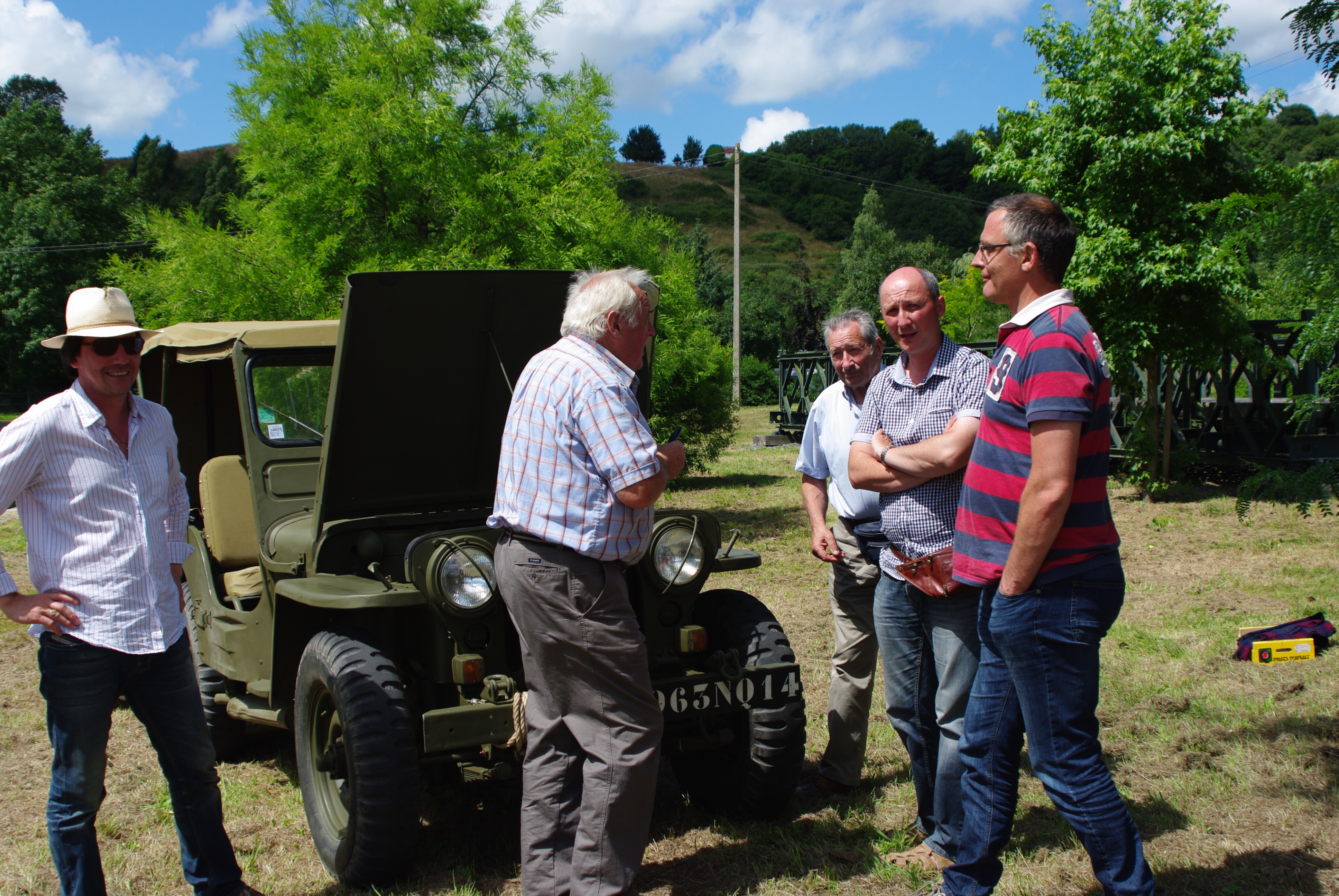
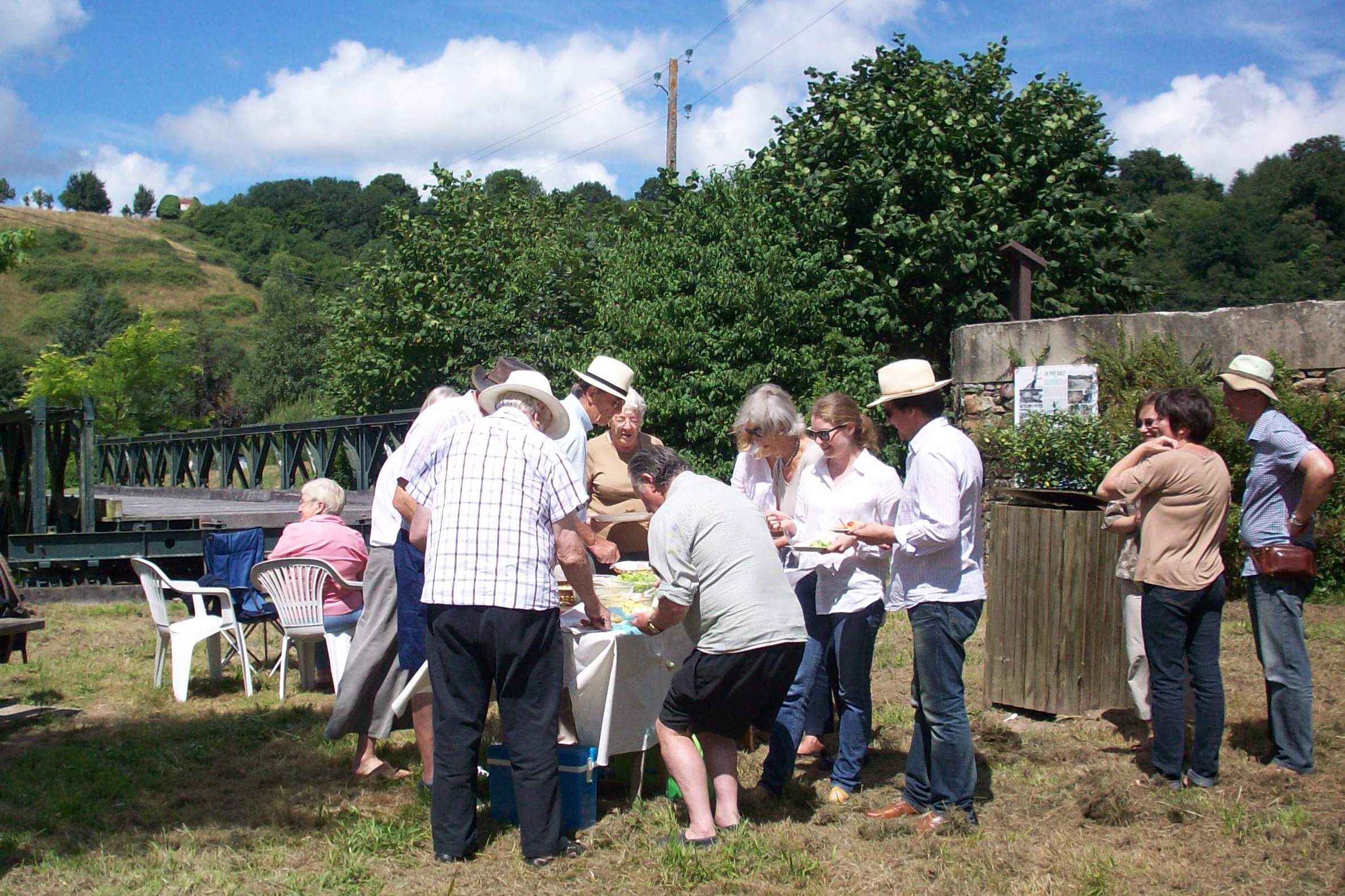 03-08-2013 The association's annual picnic took place in glorious sunshine beside the bridge and the river Vire. Members were asked to do all they could to help raise funds to pay for repainting the bridge in time for the commemorations in 2014.
03-08-2013 The association's annual picnic took place in glorious sunshine beside the bridge and the river Vire. Members were asked to do all they could to help raise funds to pay for repainting the bridge in time for the commemorations in 2014.
-

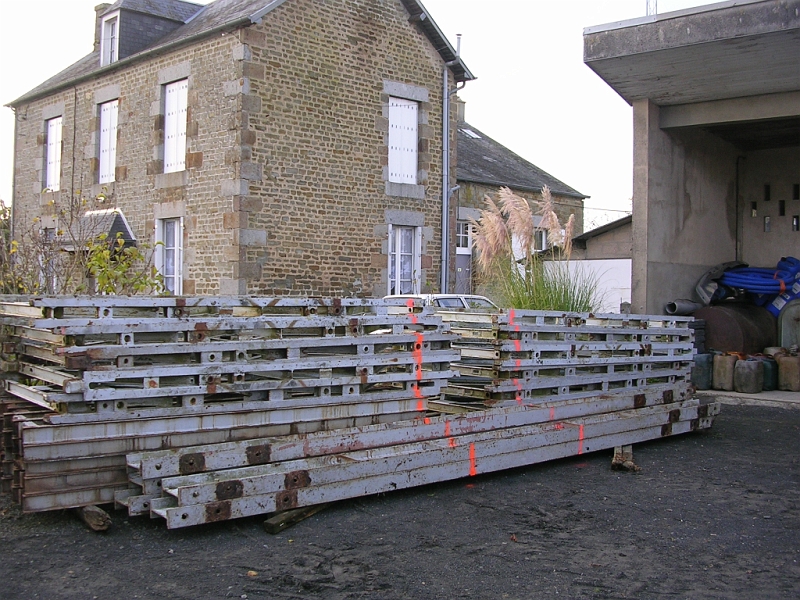 12-06-2013 The committee had decided to do something useful with Bailey Bridge parts remaining from three sections which were not used in the rebuild in 2008. Most of these parts had been stocked, without the APB's approval, in two separate commune depots of Landelles-et-Coupigny. Simon de Lautour, Lem Boekestein and Christopher Long began by collecting the smaller parts to assess the feasibility of rebuilding two or three sections for some useful purpose yet to be identified!
12-06-2013 The committee had decided to do something useful with Bailey Bridge parts remaining from three sections which were not used in the rebuild in 2008. Most of these parts had been stocked, without the APB's approval, in two separate commune depots of Landelles-et-Coupigny. Simon de Lautour, Lem Boekestein and Christopher Long began by collecting the smaller parts to assess the feasibility of rebuilding two or three sections for some useful purpose yet to be identified!
-
 19-04-2013 The APB's 2012 annual general meeting (AGM) took place at St Sever. The good news was that the Whale had found a home at a new Tank Museum to be opened at Catz, near Carentan, in June 2013. Loaned to the museum for a fixed period of years, the Whale will be restored by the museum to serve as a tank-carrying central exhibit. A fresh committee was elected and decided there were three priorities: (1) to repaint the Bailey Bridge in time for the 2014 commemorations of WWl and WWll; (2) to make better use of the three unused sections of the Bailey Bridge; and (3) to agree the future of the Whale with the Tank Museum. See Minutes of the meeting and the Financial statement of the accounts.
19-04-2013 The APB's 2012 annual general meeting (AGM) took place at St Sever. The good news was that the Whale had found a home at a new Tank Museum to be opened at Catz, near Carentan, in June 2013. Loaned to the museum for a fixed period of years, the Whale will be restored by the museum to serve as a tank-carrying central exhibit. A fresh committee was elected and decided there were three priorities: (1) to repaint the Bailey Bridge in time for the 2014 commemorations of WWl and WWll; (2) to make better use of the three unused sections of the Bailey Bridge; and (3) to agree the future of the Whale with the Tank Museum. See Minutes of the meeting and the Financial statement of the accounts.
-
 02-03-2012 The APB's 2011 annual general meeting (AGM) took place at St Sever. Exhausted and frustrated by fruitless negotiations with the town of Vire (who insisted they could only use the Whale 'bridge' if they could scrap almost half of it) Christopher Long handed over the presidency of the APB to Nigel Hay and became Hon. Founding President instead. Subsequent negotiations by other members of the committee also proved useless and the Vire project had to be abandoned and a new home found for the Whale. See Minutes of the meeting and the Financial statement of the accounts.
02-03-2012 The APB's 2011 annual general meeting (AGM) took place at St Sever. Exhausted and frustrated by fruitless negotiations with the town of Vire (who insisted they could only use the Whale 'bridge' if they could scrap almost half of it) Christopher Long handed over the presidency of the APB to Nigel Hay and became Hon. Founding President instead. Subsequent negotiations by other members of the committee also proved useless and the Vire project had to be abandoned and a new home found for the Whale. See Minutes of the meeting and the Financial statement of the accounts.
-

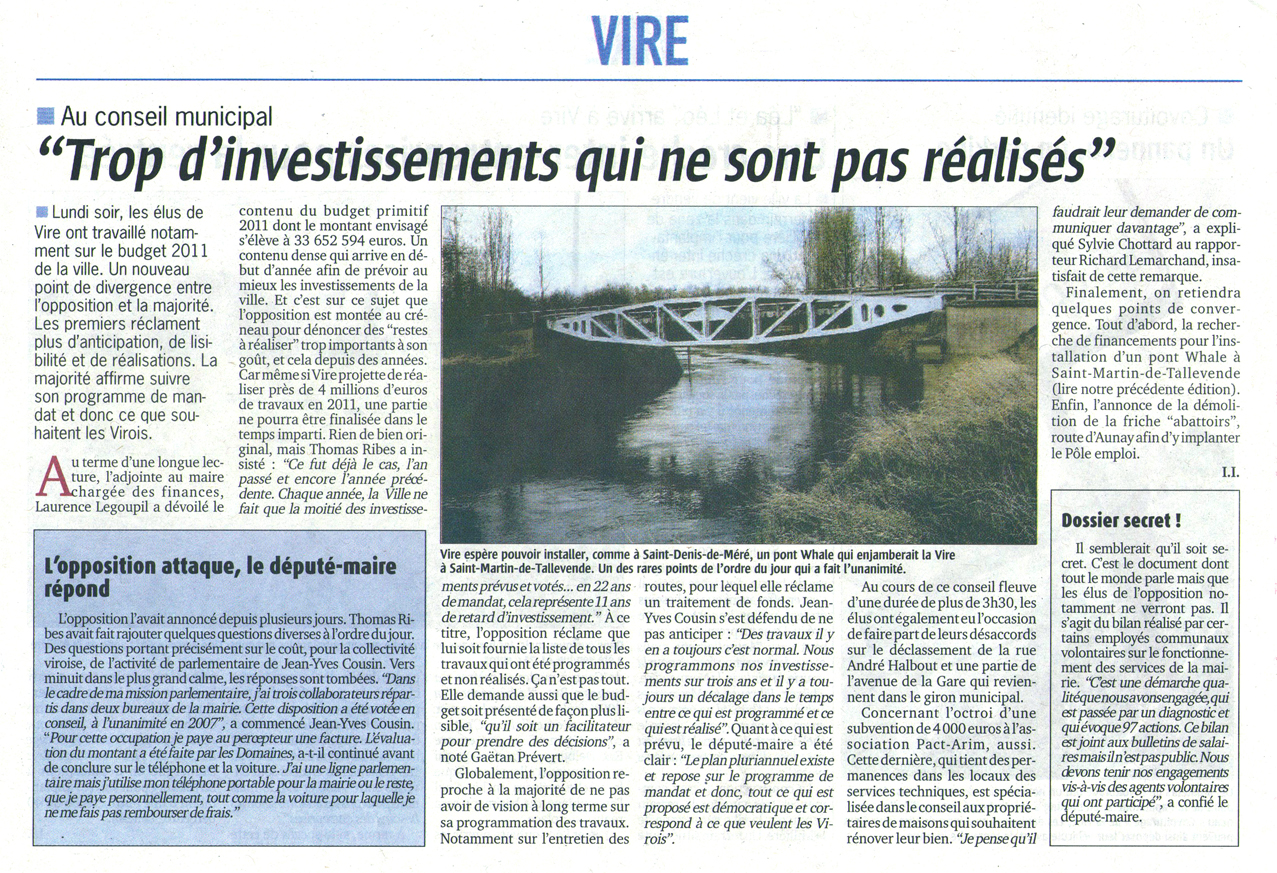
 01-02-2011 The APB's 2010 annual general meeting (AGM) had been deliberately postponed for about three months to allow the position regarding the 'Whale' project to become clearer before putting it to a vote. See Minutes of the meeting and the Financial statement of the accounts.
01-02-2011 The APB's 2010 annual general meeting (AGM) had been deliberately postponed for about three months to allow the position regarding the 'Whale' project to become clearer before putting it to a vote. See Minutes of the meeting and the Financial statement of the accounts.
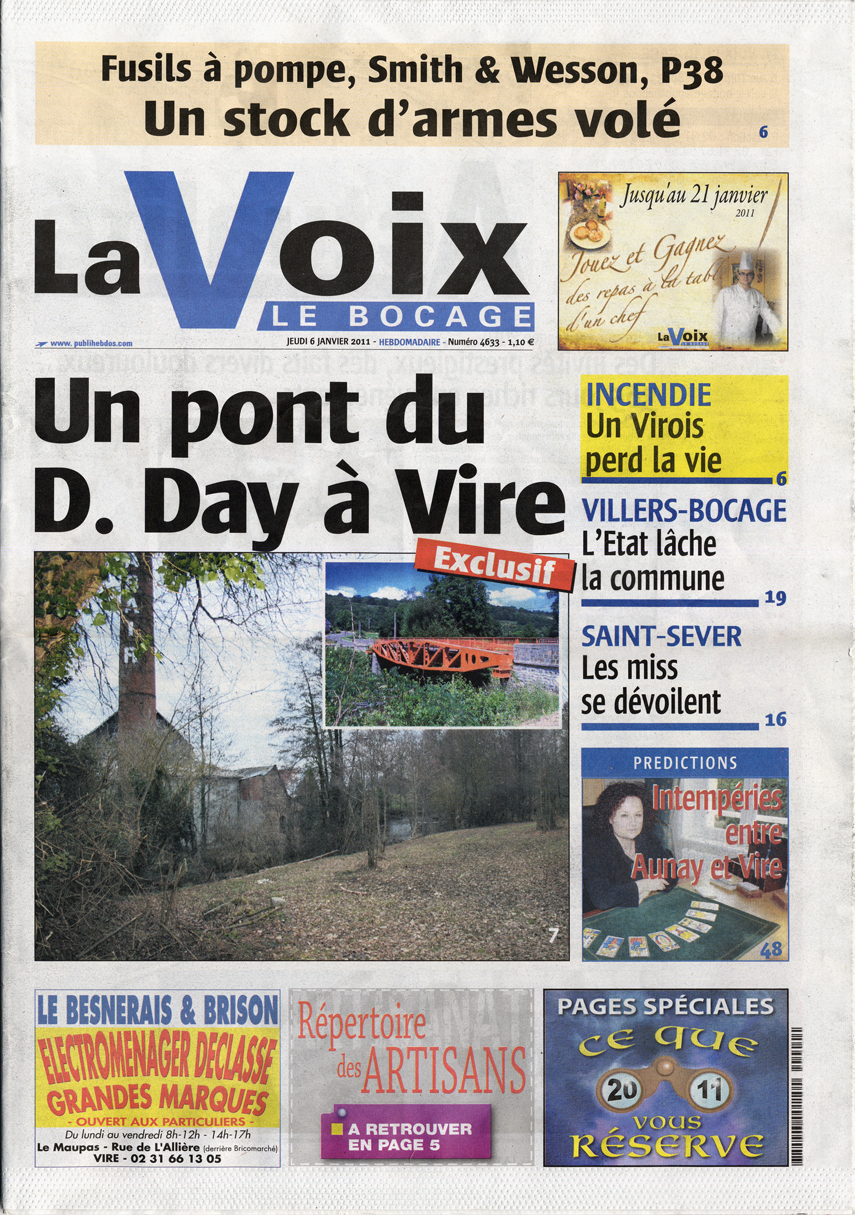

 At the meeting, held at the St Sever mairie, it was unanimously decided that we would be prepared to lend the 'Whale' to the town of Vire for a period of 100 years provided that the town could fund the entire project and maintain the 'Whale' in good condition. Catherine Godbarge (deputy mayor of Vire) and Nigel Hay (military historian) were elected committee members, replacing Henri Letellier and Marian Clarke. The annual subscription remains €5 p.a. For further information see: Accounts and APB.
At the meeting, held at the St Sever mairie, it was unanimously decided that we would be prepared to lend the 'Whale' to the town of Vire for a period of 100 years provided that the town could fund the entire project and maintain the 'Whale' in good condition. Catherine Godbarge (deputy mayor of Vire) and Nigel Hay (military historian) were elected committee members, replacing Henri Letellier and Marian Clarke. The annual subscription remains €5 p.a. For further information see: Accounts and APB.

 Finally it was agreed that the committee would reassemble as soon as the town of Vire had come to a definite decision on whether or not the project would go ahead – i.e. to use the Whale as a pedestrian bridge on the voie verte at Martilly in 2012.
Finally it was agreed that the committee would reassemble as soon as the town of Vire had come to a definite decision on whether or not the project would go ahead – i.e. to use the Whale as a pedestrian bridge on the voie verte at Martilly in 2012.
For information concerning APB and its new WHALE project... click here...
27-04-2010
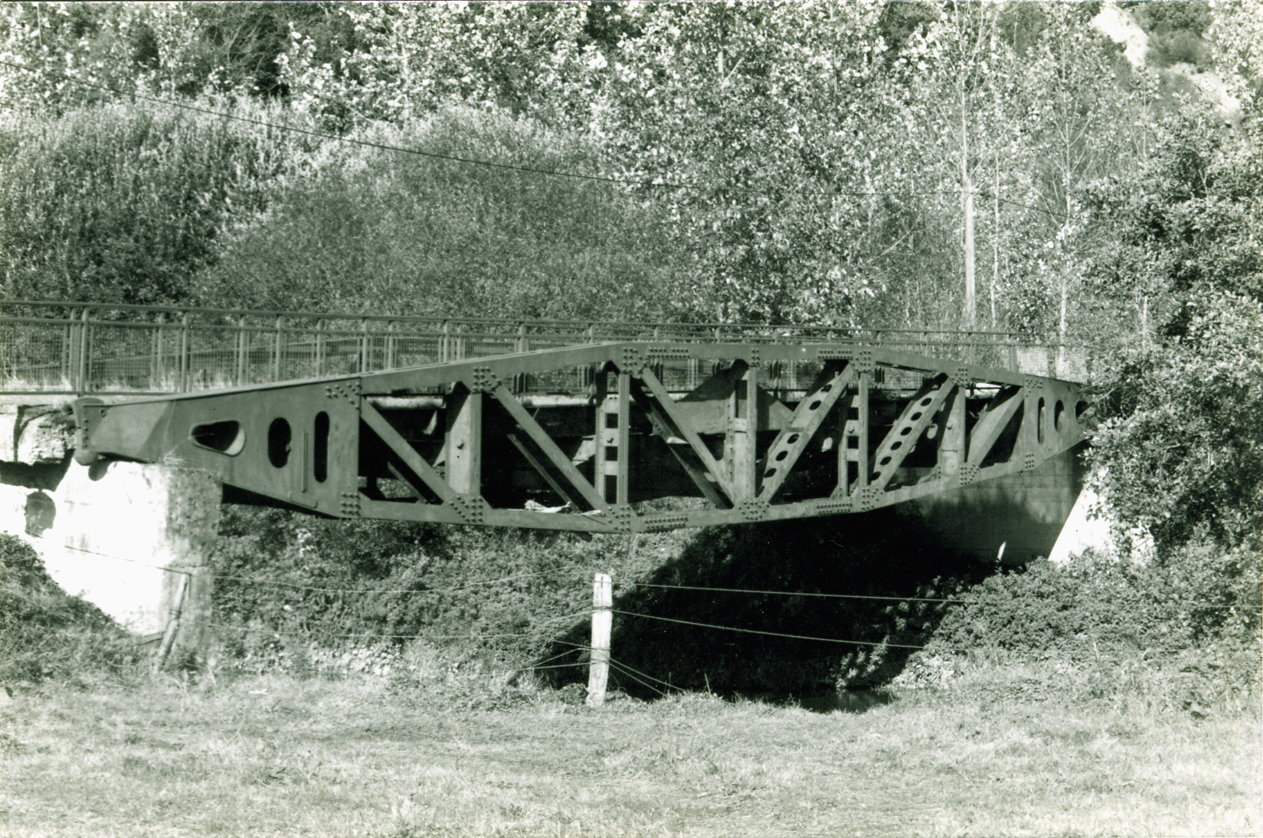 In autumn 2008 the association had been offered a rare 'Whale' element from the 1944 Mulberry 'B' artificial harbour at Arromanches. Now the deputy-mayor of Vire, Catherine Godbarge, asked us whether we could make it available to the town for the benefit of hikers and cyclists who needed it to cross the river Vire on an important long-distance tow-path walk (see Whale/Baleine). The APB immediately supported this project in principle and undertook to get formal agreement from the membership when the technicalities of the proposal became clearer.
In autumn 2008 the association had been offered a rare 'Whale' element from the 1944 Mulberry 'B' artificial harbour at Arromanches. Now the deputy-mayor of Vire, Catherine Godbarge, asked us whether we could make it available to the town for the benefit of hikers and cyclists who needed it to cross the river Vire on an important long-distance tow-path walk (see Whale/Baleine). The APB immediately supported this project in principle and undertook to get formal agreement from the membership when the technicalities of the proposal became clearer.
 In the late 1940s this Whale (one of the hundreds of 24 metre sections that had formed the floating roadways of the artificial harbours) had been re-used across the river Vire at the Grippe quarry in Pont-Farcy.
In the late 1940s this Whale (one of the hundreds of 24 metre sections that had formed the floating roadways of the artificial harbours) had been re-used across the river Vire at the Grippe quarry in Pont-Farcy.
However, in 1990, flood water had damaged its western supporting concrete pier (see picture right) and the Whale, although in excellent condition, was condemned.
 Fortunately a Monsieur Loisel, the contractor charged with its removal, had the good sense to preserve it in pieces in his quarry at Brécey rather than sell it for scrap.
Fortunately a Monsieur Loisel, the contractor charged with its removal, had the good sense to preserve it in pieces in his quarry at Brécey rather than sell it for scrap.
In August 2008, Monsieur Loisel was so impressed by the efforts of Les Amis du Pont Bailey in preserving the Bailey bridge that he offered the Whale to the APB on condition that the association found a suitable location for it.
At present only seven other 'Whales' are known to exist in Normandy (six in museum collections and one in use as a road bridge at St Denis-de Méré). Elsewhere in France a fine example, called the 'Pont d'Arromanches' at Foussemagne (90150) is still in use as a road bridge.
-
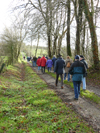
 05-12-2009 In bright sunshine about 30 members of Les Amis du Pont Bailey gathered on Mont-Pinçon, Plessis-Grimoult in Calvados, for a tour of one of the bloodiest battlefields of the Battle of Normandy.
05-12-2009 In bright sunshine about 30 members of Les Amis du Pont Bailey gathered on Mont-Pinçon, Plessis-Grimoult in Calvados, for a tour of one of the bloodiest battlefields of the Battle of Normandy.
Historian David Lecoeur led the visit, explaining how, around midday on 6 August 1944, British troops of the 129th Brigade of the 43rd Wessex Infantry Division led the attack (part of Operation Bluecoat) on this strategically vital German observation and radio transmitter position 362 metres above sea level.
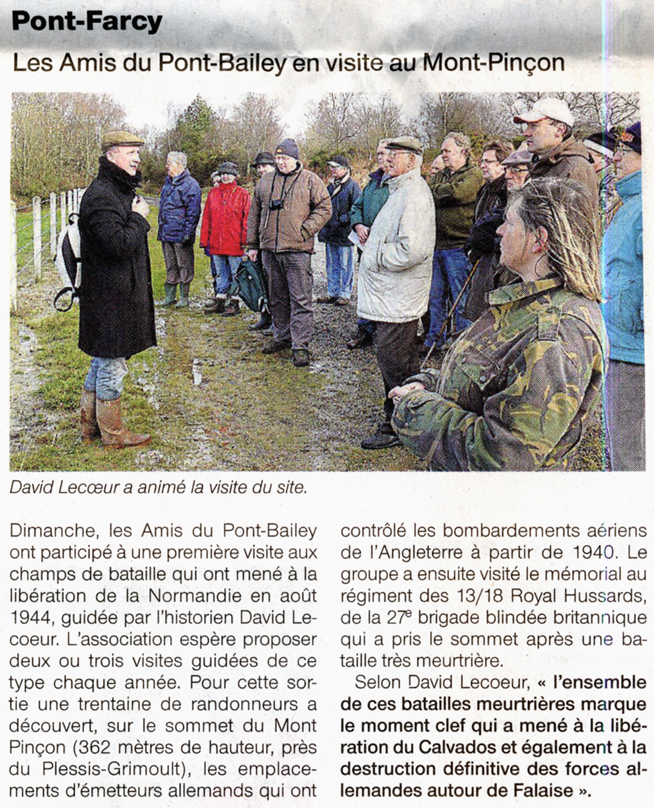 However it was the 13/18th Hussars of the 27th Armoured Brigade which eventually broke through the German lines and reached the top. Later that day infantry of the Wiltshire Regiment consolidated these positions. The next day the British liberated Le Plessis-Grimoult.
However it was the 13/18th Hussars of the 27th Armoured Brigade which eventually broke through the German lines and reached the top. Later that day infantry of the Wiltshire Regiment consolidated these positions. The next day the British liberated Le Plessis-Grimoult.
The visit ended with a tour of an underground German bunker that once communicated via a long tunnel with the command centre on top of the hill (blocked off by the British in 1947). This battle not only protected American troops from retaliatory attacks, it also turned a cohesive German army of defence into an army in full retreat. This inevitably led to its destruction near Falaise a few days later.
- 12-11-2009 Marcel Gosselin formally presented to the association a huge and very heavy steel 'pulley' which had once served to pull Bailey bridges into position (among other tasks). Marcel, who sadly died about two weeks later, discovered this British-made pulley while ploughing a field north of Bayeux (not far from Maisons) in 1945. We are very grateful to Marcel for this generous gift and for the loyal support of the Gosselin-Murie family.
- 28-09-2009 Michel Manson, Georges de Coupigny, Richard Smith and Christopher Long used welding equipment to lock the bridge's transom clamps in position. Regrettably this was necessary following the theft of four security chains across the two ends of the bridge (reported to the St Sever gendarmerie 07-09-2009) and attempts by someone to unscrew and remove several transom clamps, vital to the structure of the bridge.
-


 08-08-2009 In glorious sunshine about 400 people gathered beside the river Vire at the Bailey bridge in Pont-Farcy for an Inauguration Ceremony of the Bailey Bridge which also marked the 65th anniversary of the Liberation of Normandy.
08-08-2009 In glorious sunshine about 400 people gathered beside the river Vire at the Bailey bridge in Pont-Farcy for an Inauguration Ceremony of the Bailey Bridge which also marked the 65th anniversary of the Liberation of Normandy.
After a bugle call played by Major David Glossop (Royal Marines), Georges de Coupigny, (président d'Animations en Pays Severin) introduced the ceremony. Christopher Long (président des Amis du Pont Bailey) then made a speech of welcome.
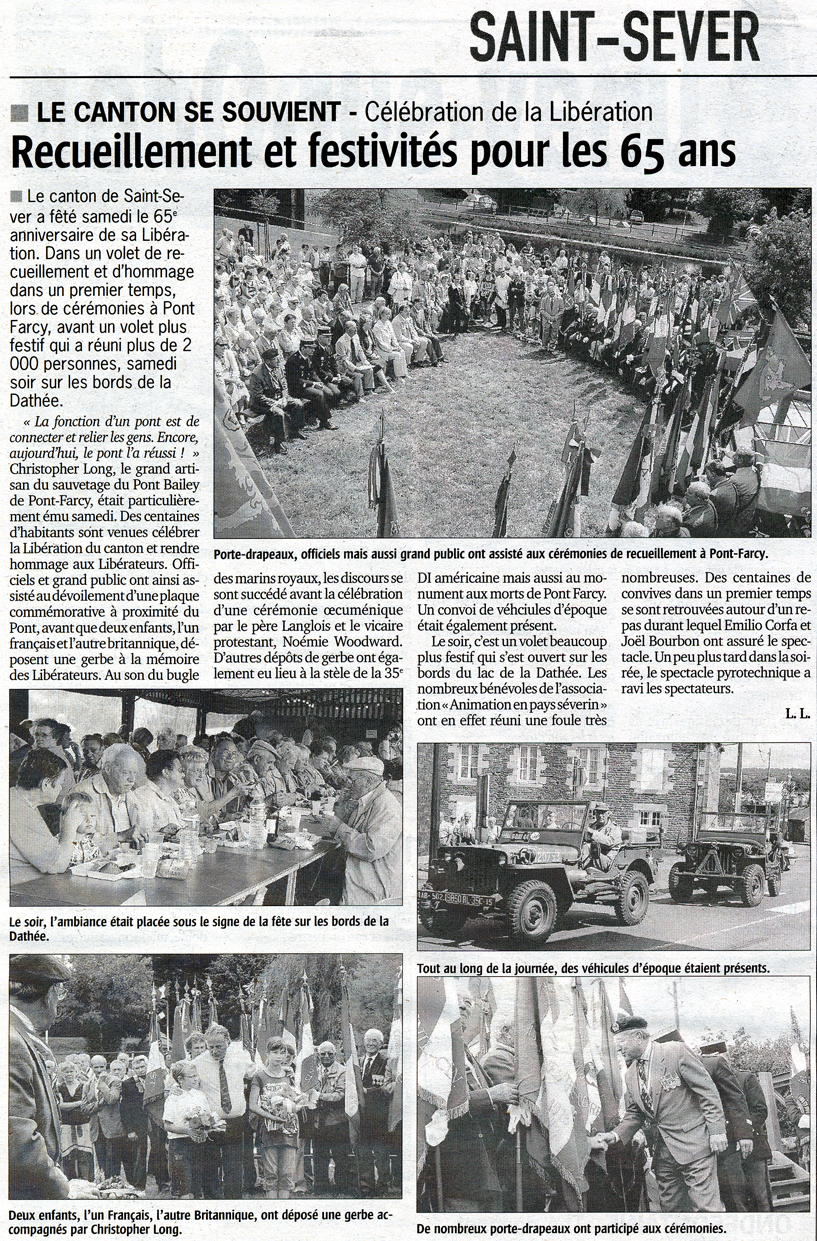
 Among the official guests were: Catherine Godbarge (representing the député-maire de Vire, Jean-Yves Cousin); Annie Bihel (conseiller régional); Yves Rondel (conseiller général); Capitaine Olivier Juillon and Major Philippe Hardouin (gendarmerie de Vire); Georges Ravenel (président d'Intercom Severine); Commander Mark Whelan (president of the Royal Navy Association – France Nord); Alain Deguette (maire de Pont-Farcy); and Alain Briard (maire délégué de Pleines-Oeuvres).
Among the official guests were: Catherine Godbarge (representing the député-maire de Vire, Jean-Yves Cousin); Annie Bihel (conseiller régional); Yves Rondel (conseiller général); Capitaine Olivier Juillon and Major Philippe Hardouin (gendarmerie de Vire); Georges Ravenel (président d'Intercom Severine); Commander Mark Whelan (president of the Royal Navy Association – France Nord); Alain Deguette (maire de Pont-Farcy); and Alain Briard (maire délégué de Pleines-Oeuvres).
A large wall-mounted information panel was then unveiled by Catherine Godbarge and Yves Rondel who both made speeches, followed by Annie Bihel, Georges Ravenel and the mayor of Pont-Farcy.
 A short open-air ecumenical service was then led by l'Abbé Yves Langlois and pastor Noémie Woodward. Two bouquets of flowers were then laid beneath the panel by Justine Bourrel and Connor Lorkin on behalf of the APB and in memory of our liberators in 1944. Annie Bihel and Georges Ravenel laid a wreath on behalf of the Conseil Régional, Commander Mark Whelan for the Royal Navy and Captain John Seymour-Williams for the Royal Engineers. Others laid flowers privately.
A short open-air ecumenical service was then led by l'Abbé Yves Langlois and pastor Noémie Woodward. Two bouquets of flowers were then laid beneath the panel by Justine Bourrel and Connor Lorkin on behalf of the APB and in memory of our liberators in 1944. Annie Bihel and Georges Ravenel laid a wreath on behalf of the Conseil Régional, Commander Mark Whelan for the Royal Navy and Captain John Seymour-Williams for the Royal Engineers. Others laid flowers privately.
Major David Glossop then played the Last Post and Reveille to mark the one minute's silence. The invited guests then formally acknowledged the 30 standard bearers of the local communes and two British veterans, Col. Bruce Dyson representing the British Army and Ray Yeowell representing the Royal Navy. [We were very sorry that, at the last minute, John Walters, a veteran airman of WWll who lives near Pont-Hébert, was prevented from representing the RAF.]
Led by the standard-bearers and followed by about 20 WWll military vehicles, everyone then walked to acknowledge the nearby American memorial and the commune's own war memorial at the church before gathering for a vin d'honneur at the salle des fêtes.
Special thanks go to: Henri Letellier for his photo exhibition; Bill & Jacqueline Twohigg for manning the APB stand; Richard & Lynda Smith for bridge preparations; Alain Briard, Gerard Colet, Joseph Sevaux, Rémy Gesnouin, André Lelouvier, Michel Sanson and Roger Ladroue for their excellent preparation of the salle des fêtes, decoration of the town and parking arrangements.
-
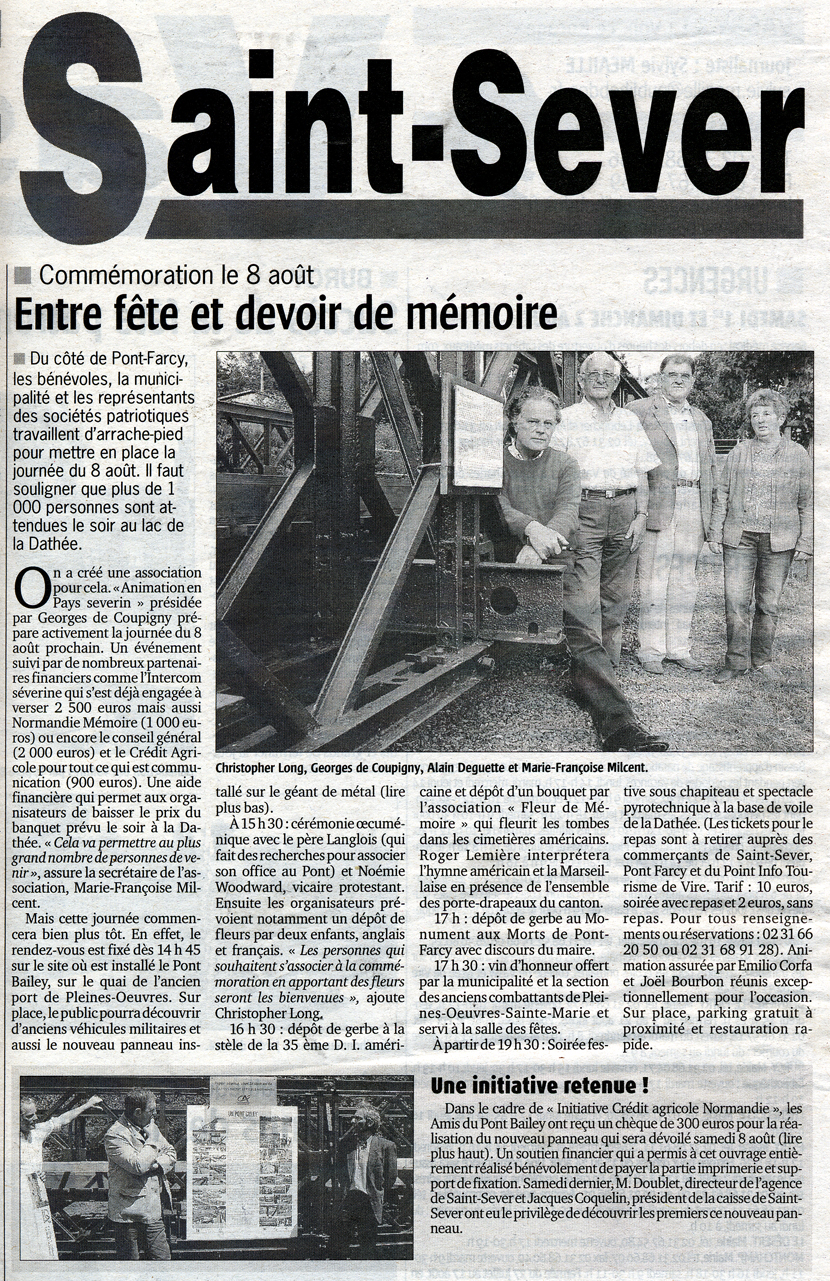
 25-07-2009 A lunchtime reception was held at the bridge by Animations en Pays Severin, hosted by its president Georges de Coupigny, to allow directors of Crédit Agricole to be photographed unveiling the new plaque (which will in fact be officially unveiled on 8th August).
25-07-2009 A lunchtime reception was held at the bridge by Animations en Pays Severin, hosted by its president Georges de Coupigny, to allow directors of Crédit Agricole to be photographed unveiling the new plaque (which will in fact be officially unveiled on 8th August).
The bank had provided APS with sponsorship of €1,300 to help finance the evening party on 8th August.
There were about 40 guests, led by Yves Rondel (conseiller général) and Georges Ravenel (président d'Intercom Severine).
-

 15-07-2009 Les Amis du Pont Bailey held their Assemblée Générale at the Mairie in St Sever. A new committee was elected: Christopher Long (président), Georges de Coupigny (vice président), Pierre Desjardins (sécretaire), Sarah Long (trésorière), Jean-Paul Daval (sapeur officiel), Marian Clarke, Richard Smith, Henri Letellier and Bill Twohigg.
15-07-2009 Les Amis du Pont Bailey held their Assemblée Générale at the Mairie in St Sever. A new committee was elected: Christopher Long (président), Georges de Coupigny (vice président), Pierre Desjardins (sécretaire), Sarah Long (trésorière), Jean-Paul Daval (sapeur officiel), Marian Clarke, Richard Smith, Henri Letellier and Bill Twohigg.
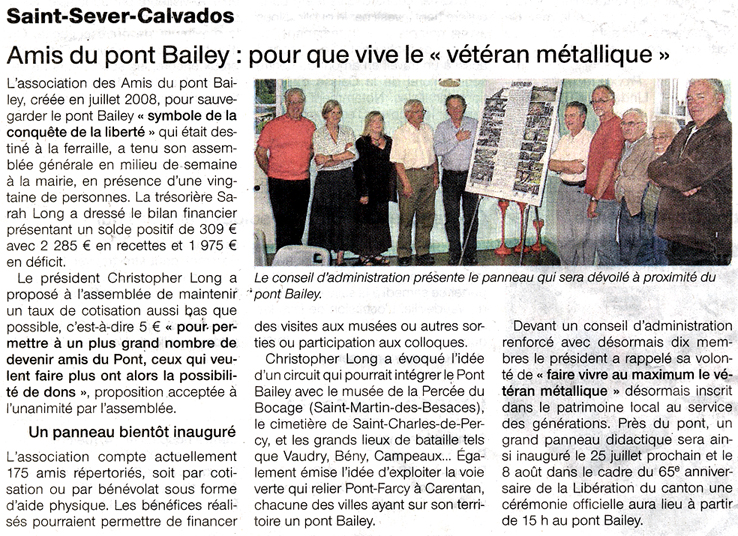 The membership fee was fixed at €5 for 2009/10 and the association's future events were discussed (e.g. battlefield tours, talks and visits to be offered to members). While agreeing final arrangements for the inauguration ceremony at the bridge on 8 August 2009, a large new explanatory panel, to be unveiled on a wall beside the bridge that day, was shown to members and to the press. The annual accounts were duly agreed.
The membership fee was fixed at €5 for 2009/10 and the association's future events were discussed (e.g. battlefield tours, talks and visits to be offered to members). While agreeing final arrangements for the inauguration ceremony at the bridge on 8 August 2009, a large new explanatory panel, to be unveiled on a wall beside the bridge that day, was shown to members and to the press. The annual accounts were duly agreed.
-


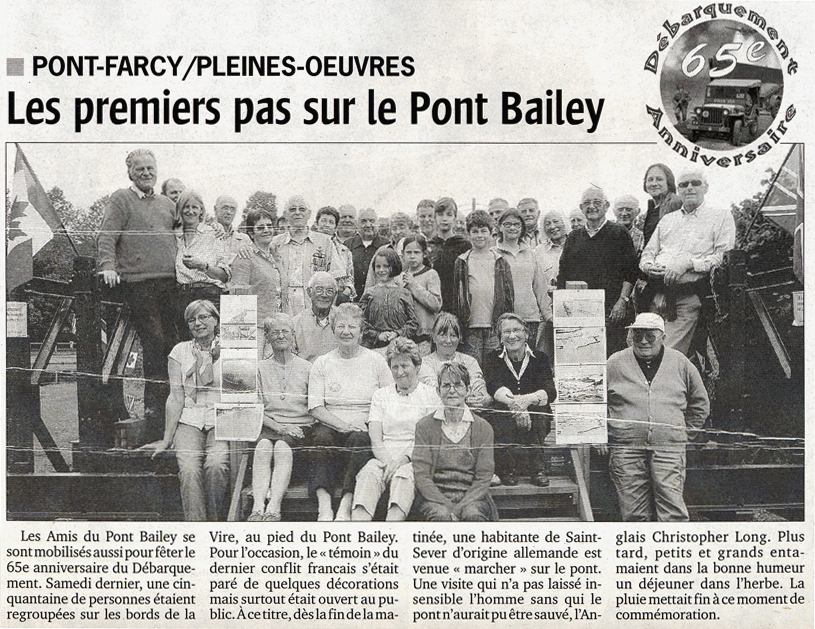 06-06-2009 All along the Normandy coast veterans of the Battle of Normandy joined huge crowds gathering to commemorate the 65th anniversary of the D-Day landings. Meanwhile, here in Pont-Farcy, more than 50 friends gathered from numerous surrounding communes for a picnic lunch, attended by the mayor of Pleines-Oeuvres Alain Briard, on the banks of the river Vire. For the first time the bridge was accessible to members of the public and, by happy coincidence, the very first person to climb onto our newly restored bridge was a German lady who lives nearby. Although this may be the last time we see the D-Day landings marked by formal, international ceremonies, we very much hope that the sacrifices made for our liberty during these great and tragic battles will continue to be remembered here at the Bailey bridge in Pont-Farcy.
06-06-2009 All along the Normandy coast veterans of the Battle of Normandy joined huge crowds gathering to commemorate the 65th anniversary of the D-Day landings. Meanwhile, here in Pont-Farcy, more than 50 friends gathered from numerous surrounding communes for a picnic lunch, attended by the mayor of Pleines-Oeuvres Alain Briard, on the banks of the river Vire. For the first time the bridge was accessible to members of the public and, by happy coincidence, the very first person to climb onto our newly restored bridge was a German lady who lives nearby. Although this may be the last time we see the D-Day landings marked by formal, international ceremonies, we very much hope that the sacrifices made for our liberty during these great and tragic battles will continue to be remembered here at the Bailey bridge in Pont-Farcy.
-

 29-05-2009 The bridge was finally completed, ready for its first Open Days on the 6th June and 8th August 2009. Over two days, Bill & Jacqueline Twohigg had helped Richard & Lynda Smith to treat all the timbers with 30 litres of 'Targobois', bought with the last of our funds... The purpose-built detachable steps were set up and a pair of chains attached at each end of the bridge to discourage illegal access. All that remains to be done this year is to organise a group of volunteers to re-touch some of the paint-work. A 120cm x 100cm wall panel, explaining the history and significance of the Bailey bridges, will be unveiled at the 8th August opening ceremony linked to events marking the 65th anniversary of the Liberation.
29-05-2009 The bridge was finally completed, ready for its first Open Days on the 6th June and 8th August 2009. Over two days, Bill & Jacqueline Twohigg had helped Richard & Lynda Smith to treat all the timbers with 30 litres of 'Targobois', bought with the last of our funds... The purpose-built detachable steps were set up and a pair of chains attached at each end of the bridge to discourage illegal access. All that remains to be done this year is to organise a group of volunteers to re-touch some of the paint-work. A 120cm x 100cm wall panel, explaining the history and significance of the Bailey bridges, will be unveiled at the 8th August opening ceremony linked to events marking the 65th anniversary of the Liberation.
-
 10-05-2009 Again, we are immensely grateful for the energy and talents of master carpenter Richard Smith who spent almost three days preparing and laying the twelve 'ribands' (timber 'kerbs' running down each side of the deck) which, like the orginal 'chesses' (timber planking), had vanished from the site of the original bridge at Fourneaux by the time we came to save it. Using additional lengths of Douglas fir planking, Richard was helped by Georges and Arnaud de Coupigny. Six of the ribands were sponsored by Haydn Morgan and six by members of the committee.
10-05-2009 Again, we are immensely grateful for the energy and talents of master carpenter Richard Smith who spent almost three days preparing and laying the twelve 'ribands' (timber 'kerbs' running down each side of the deck) which, like the orginal 'chesses' (timber planking), had vanished from the site of the original bridge at Fourneaux by the time we came to save it. Using additional lengths of Douglas fir planking, Richard was helped by Georges and Arnaud de Coupigny. Six of the ribands were sponsored by Haydn Morgan and six by members of the committee.
-
 06-05-2009 The Conseil Général (Calvados) agreed that there would be no requirement for a security fence around the bridge provided that signs clearly deny any public access onto the bridge (except on occasional specially supervised open days). [On 20-05-2009 the Monsieur Jolimaitre of the Conseil Général sent us a 'convention' (formal agreement) allowing the bridge to occupy the site on certain conditions which the committee agreed to be reasonable and acceptable. This was duly signed and returned on 28-05-2009.] Subsequently the APB informed the Conseil Général that the bridge would be publicly accessible on 6 June and 8 August 2009 in connection with events marking the 65th anniversary of D-Day and the Battle of Normandy (see CG14 agreement).
06-05-2009 The Conseil Général (Calvados) agreed that there would be no requirement for a security fence around the bridge provided that signs clearly deny any public access onto the bridge (except on occasional specially supervised open days). [On 20-05-2009 the Monsieur Jolimaitre of the Conseil Général sent us a 'convention' (formal agreement) allowing the bridge to occupy the site on certain conditions which the committee agreed to be reasonable and acceptable. This was duly signed and returned on 28-05-2009.] Subsequently the APB informed the Conseil Général that the bridge would be publicly accessible on 6 June and 8 August 2009 in connection with events marking the 65th anniversary of D-Day and the Battle of Normandy (see CG14 agreement).
-
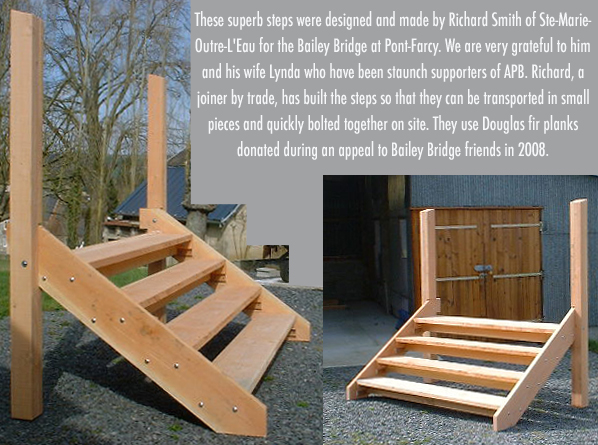 03-03-2009 Richard Smith of Ste Marie-Outre-L'Eau unveiled a magnificent flight of steps specially designed and built for the bridge. Richard's ingenious steps, made from some of the remaining planks kindly donated by association friends in September 2008, consist of six elements which can be quickly unbolted for easy transport and storeage. We are all very grateful to Richard and his wife Lynda. [For safety reasons, the steps will only be used on special occasions and for official open days.]
03-03-2009 Richard Smith of Ste Marie-Outre-L'Eau unveiled a magnificent flight of steps specially designed and built for the bridge. Richard's ingenious steps, made from some of the remaining planks kindly donated by association friends in September 2008, consist of six elements which can be quickly unbolted for easy transport and storeage. We are all very grateful to Richard and his wife Lynda. [For safety reasons, the steps will only be used on special occasions and for official open days.]
-
 24-10-2008 The aftermath: After a week during which large numbers of people had visited the bridge, Laetitia Lemaire in La Voix le Bocage reported the inauguration ceremony, as did La Manche Libre.
24-10-2008 The aftermath: After a week during which large numbers of people had visited the bridge, Laetitia Lemaire in La Voix le Bocage reported the inauguration ceremony, as did La Manche Libre.
-
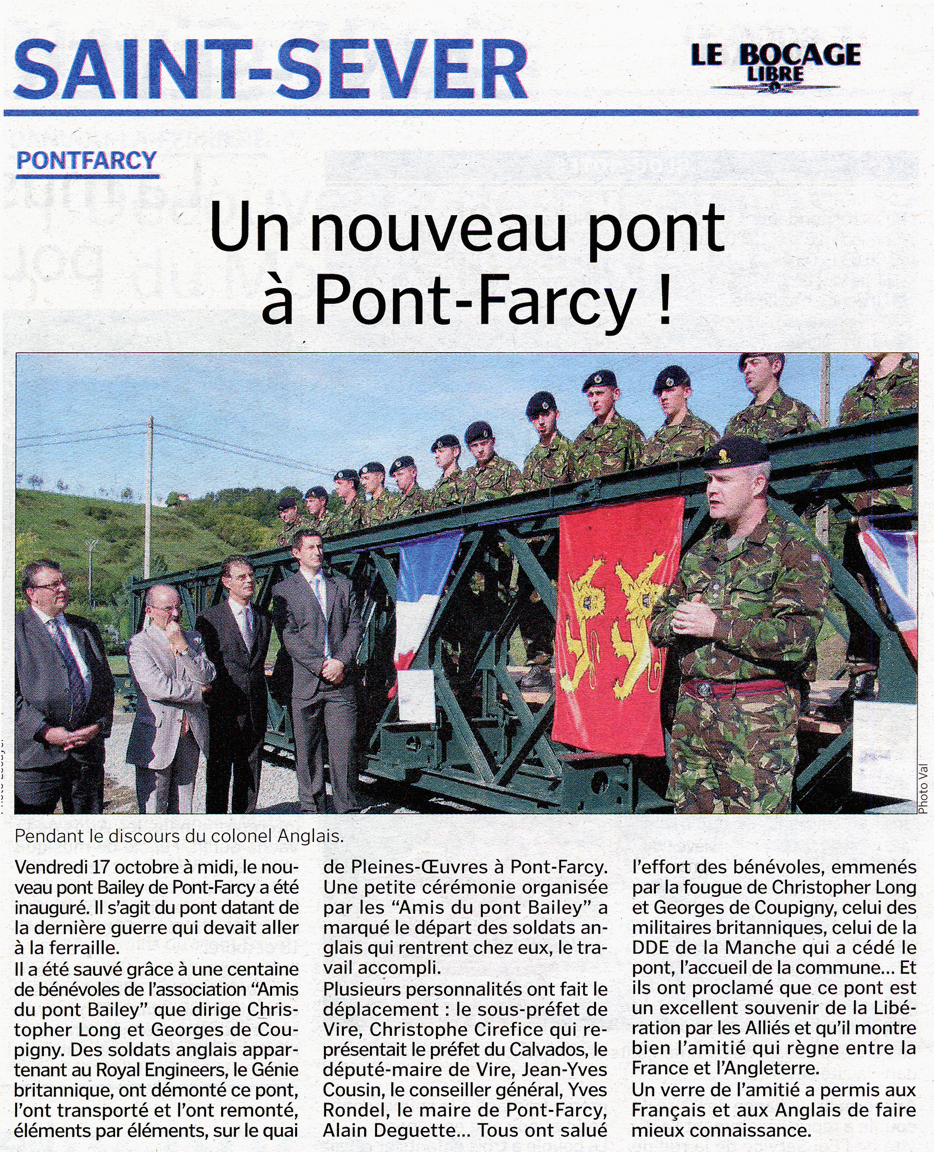 17-10-2008 Inauguration of the bridge: (see photos) On a gloriously sunny day, about 250 people gathered at midday in the old port of Pont-Farcy for a ceremony to thank the Royal Engineers (Combat Engineer School) for their wonderful work over the previous 12 days and to unveil commemorative plaques in French and English.
17-10-2008 Inauguration of the bridge: (see photos) On a gloriously sunny day, about 250 people gathered at midday in the old port of Pont-Farcy for a ceremony to thank the Royal Engineers (Combat Engineer School) for their wonderful work over the previous 12 days and to unveil commemorative plaques in French and English.
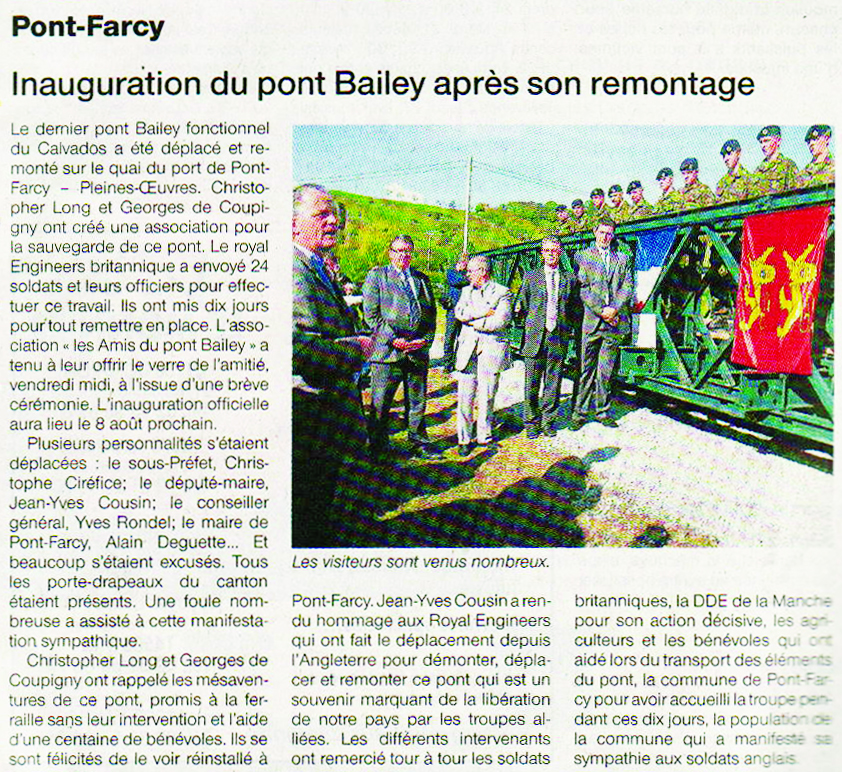 Georges de Coupigny vice-president of Les Amis du Pont Bailey opened the proceedings as the Engineers, commanded by Capt. Ian Higginbotham, took up position on their bridge while flag-bearers from local communes formed up alongside. He stressed that today's ceremony was to thank the Royal Engineers and that the official opening would take place on 08-08-2009, marking the 65th anniversary of the Liberation of Normandy.
Georges de Coupigny vice-president of Les Amis du Pont Bailey opened the proceedings as the Engineers, commanded by Capt. Ian Higginbotham, took up position on their bridge while flag-bearers from local communes formed up alongside. He stressed that today's ceremony was to thank the Royal Engineers and that the official opening would take place on 08-08-2009, marking the 65th anniversary of the Liberation of Normandy.
 Christopher Long, president of Les Amis du Pont Bailey, then made a speech in tribute to the Royal Engineers and to the generous contributions of more than one hundred Amis du Pont Bailey who had helped either practically or through donations to bring this four-month long project to a successful conclusion – an entirely voluntary effort that cost nothing to local communes or to the départment.
Christopher Long, president of Les Amis du Pont Bailey, then made a speech in tribute to the Royal Engineers and to the generous contributions of more than one hundred Amis du Pont Bailey who had helped either practically or through donations to bring this four-month long project to a successful conclusion – an entirely voluntary effort that cost nothing to local communes or to the départment.
 M. Le Sous-Préfet de Vire, Christophe Ciréfice (representing M. Le Préfet du Calvados) then unveiled the French langauge version of the plaque while Lt Col Damian McKeown RE MBE (representing the Royal Engineers) unveiled the English language version. Accompanying them them were M. Le Député de Vire Jean-Yves Cousin and RSM Stewart of the Royal Engineers.
M. Le Sous-Préfet de Vire, Christophe Ciréfice (representing M. Le Préfet du Calvados) then unveiled the French langauge version of the plaque while Lt Col Damian McKeown RE MBE (representing the Royal Engineers) unveiled the English language version. Accompanying them them were M. Le Député de Vire Jean-Yves Cousin and RSM Stewart of the Royal Engineers.
 Other honoured guests were the conseillers généraux M. Yves Rondel and M. Marc Andreu Sabater and the mayors of Pont-Farcy (M. Alain Deguette), Pleines-Oevres (M. Alain Briard) and Fourneaux (M. Yves Hermon).
Other honoured guests were the conseillers généraux M. Yves Rondel and M. Marc Andreu Sabater and the mayors of Pont-Farcy (M. Alain Deguette), Pleines-Oevres (M. Alain Briard) and Fourneaux (M. Yves Hermon).
 The ceremony came to an end with speeches by Lt Col D. McKeown, M. J-Y Cousin and M. C. Ciréfice all of whom spoke warmly of their pride and pleasure in this Anglo-French collaboration, their gratitude to the forebears of the Royal Engineers who had first laid this bridge during WWll, and of the deep significance, past, present and future, that the Bailey bridge represented to them all. Col McKeown pointed out that this exercise in bridge-building was simply a continuing task for Royal Engineers today; M. Cousin, the son of a French résistant talked of Bailey bridges having been a real and symbolic emblem of hope and liberation after the dark days of occupation during WWll. The heart of France began to beat again, he said, when Allied troops landed in Normandy in 1944. M. Ciréfice too was proud to be associated with a project that had been a collaboration between Britain and France.
The ceremony came to an end with speeches by Lt Col D. McKeown, M. J-Y Cousin and M. C. Ciréfice all of whom spoke warmly of their pride and pleasure in this Anglo-French collaboration, their gratitude to the forebears of the Royal Engineers who had first laid this bridge during WWll, and of the deep significance, past, present and future, that the Bailey bridge represented to them all. Col McKeown pointed out that this exercise in bridge-building was simply a continuing task for Royal Engineers today; M. Cousin, the son of a French résistant talked of Bailey bridges having been a real and symbolic emblem of hope and liberation after the dark days of occupation during WWll. The heart of France began to beat again, he said, when Allied troops landed in Normandy in 1944. M. Ciréfice too was proud to be associated with a project that had been a collaboration between Britain and France.
 Drinks were then served in a military tent nearby for the many guests, including some who had come from England specially for the event. And at a private lunch at the Royal Engineers' camp afterwards (see photos) it was universally acknowledged that a huge debt was owed by everyone to the relentless efforts of Graham Hughes who had worked alongside the Royal Engineers as a civilian 'sapper' throughout. He was duly presented with the 'sapper's' prize of a model sapper.
Drinks were then served in a military tent nearby for the many guests, including some who had come from England specially for the event. And at a private lunch at the Royal Engineers' camp afterwards (see photos) it was universally acknowledged that a huge debt was owed by everyone to the relentless efforts of Graham Hughes who had worked alongside the Royal Engineers as a civilian 'sapper' throughout. He was duly presented with the 'sapper's' prize of a model sapper.
-
 15-10-2008 Finishing touches: (see photos) In the two days before the opening ceremony, the Royal Engineers completed the paintwork (see photos), spread a rectangle of gravel under the bridge and the laid the bridge's 'stringers'. With help from Colin King, Richard & Lynda Smith and others, the planks ('chesses') were sawn to fit and laid (see photos) . [The same team secured the 'chesses' temporarily, the day after the opening on the 17th, though permanent 'ribbons' and 'ribbon bolts' will later be fitted, along with access steps at one end of the bridge.]
15-10-2008 Finishing touches: (see photos) In the two days before the opening ceremony, the Royal Engineers completed the paintwork (see photos), spread a rectangle of gravel under the bridge and the laid the bridge's 'stringers'. With help from Colin King, Richard & Lynda Smith and others, the planks ('chesses') were sawn to fit and laid (see photos) . [The same team secured the 'chesses' temporarily, the day after the opening on the 17th, though permanent 'ribbons' and 'ribbon bolts' will later be fitted, along with access steps at one end of the bridge.]
-
 14-10-2008 Local farmer Michel Manson kindly delivered 12 tonnes of gravel (a gift from Col. Graham Gibbs) which will be spread under the bridge. Meanwhile 110 planks to form the deck and the flight of four steps at each end of the bridge (all sponsored by supporters) were delivered by the Scierie Gaté (see photos) . The sappers were by this time painting the sub-structure of the bridge (see photos) .
14-10-2008 Local farmer Michel Manson kindly delivered 12 tonnes of gravel (a gift from Col. Graham Gibbs) which will be spread under the bridge. Meanwhile 110 planks to form the deck and the flight of four steps at each end of the bridge (all sponsored by supporters) were delivered by the Scierie Gaté (see photos) . The sappers were by this time painting the sub-structure of the bridge (see photos) .
- 13-10-2008 The Royal Engineers took a day off from the project, visiting WWll museums, battle-fields and cemeteries.
-
 11-10-2008 Rebuilding the bridge: (see photos) The first five sections of the bridge were laid on the prepared site in the picnic area beside the river Vire at Pont-Farcy. Arlette and Rolf Röttges generously provided 36 bottles of their own cider for the opening ceremony, while Samuel Woodward kindly offered to translate the proposed memorial plaque into French.
11-10-2008 Rebuilding the bridge: (see photos) The first five sections of the bridge were laid on the prepared site in the picnic area beside the river Vire at Pont-Farcy. Arlette and Rolf Röttges generously provided 36 bottles of their own cider for the opening ceremony, while Samuel Woodward kindly offered to translate the proposed memorial plaque into French.
-
 10-10-2008 Preparing the ground: (see photos) After three days spent dismantling the bridge, the bulk of the remaining heavy sections (transoms, panels, sway bracings and bracing frames) were transferred from the Fourneaux site to Pont-Farcy by local farmer Maurice Lelouvier with traffic control provided by Major Philippe Hardouin of the Vire Gendarmerie (see photos). Meanwhiile, another group of Royal Engineers were stripping off the turf, levelling and preparing the ground at Pont-Farcy as the first six (of twelve) huge oak blocks to support the new structure were moved from the Sciérie Gaté (see photos). La Voix le Bocage carried an article by Isabelle Innocenti on the arrival of the Royal Engineers.
10-10-2008 Preparing the ground: (see photos) After three days spent dismantling the bridge, the bulk of the remaining heavy sections (transoms, panels, sway bracings and bracing frames) were transferred from the Fourneaux site to Pont-Farcy by local farmer Maurice Lelouvier with traffic control provided by Major Philippe Hardouin of the Vire Gendarmerie (see photos). Meanwhiile, another group of Royal Engineers were stripping off the turf, levelling and preparing the ground at Pont-Farcy as the first six (of twelve) huge oak blocks to support the new structure were moved from the Sciérie Gaté (see photos). La Voix le Bocage carried an article by Isabelle Innocenti on the arrival of the Royal Engineers.
- 09-10-2008 Col. Graham Gibbs RE and Capt. Andy Cooney RE made a day-long visit from England to inspect progress on the project and had breakfast and lunch at Pont-Farcy with committee members of Les Amis du Pont Bailey.
-
 08-10-2008 Moving the bridge: (see photos) The first sections of the bridge were transported from Fourneaux to Pont-Farcy by local farmers Michel Manson and David Dauvers, using two tractors and a trailer. On the same day another volunteer, Bernard Barbier, delivered four tonnes of gravel to the new site for the footings which had been dug out the previous week by Rémy Lerenard of the contractors Gosselin-Murie. The soldiers were most grateful to Guillaume Bourrel who supplied them with copious quantities of apples and nuts!
08-10-2008 Moving the bridge: (see photos) The first sections of the bridge were transported from Fourneaux to Pont-Farcy by local farmers Michel Manson and David Dauvers, using two tractors and a trailer. On the same day another volunteer, Bernard Barbier, delivered four tonnes of gravel to the new site for the footings which had been dug out the previous week by Rémy Lerenard of the contractors Gosselin-Murie. The soldiers were most grateful to Guillaume Bourrel who supplied them with copious quantities of apples and nuts!
-
 07-10-2008 Christophe Lecuyer of Vire FM radio broadcast a lead news item on the work of the Royal Engineers at the bridge as the process of dismantling it gathered pace.
07-10-2008 Christophe Lecuyer of Vire FM radio broadcast a lead news item on the work of the Royal Engineers at the bridge as the process of dismantling it gathered pace.
-
 06-10-2008 Dismantling the bridge: (see photos) On Monday evening Marc Sadouni of France 3 Television (Soir 3 news) reported the arrival of the twenty-four members of the Royal Engineers (CES). The engineers had already started work dismantling the bridge at Fourneaux with the invaluable help of volunteer Graham Hughes (aided by Colin King). The tricky task of lowering the four 21 metre long panels and extracting their panel pins was finished within three days. By Thursday 9 October the 36 panels, along with their rakers, stringers, transoms, sway bracings and bracing frames were assembled ready for transport to the new Pont-Farcy site.
06-10-2008 Dismantling the bridge: (see photos) On Monday evening Marc Sadouni of France 3 Television (Soir 3 news) reported the arrival of the twenty-four members of the Royal Engineers (CES). The engineers had already started work dismantling the bridge at Fourneaux with the invaluable help of volunteer Graham Hughes (aided by Colin King). The tricky task of lowering the four 21 metre long panels and extracting their panel pins was finished within three days. By Thursday 9 October the 36 panels, along with their rakers, stringers, transoms, sway bracings and bracing frames were assembled ready for transport to the new Pont-Farcy site.
- 05-10-2008 Twenty-four members of the British Royal Engineers, led by Capt. Ian Higginbotham, arrived in the evening and set themselves up in the Pont-Farcy camp site. They included:
- Capt. Ian Higginbotham
- WO2 Scott Jinks
- SSgt Neil Viveash
- SSgt Adam Dye
- Cpl Brian Rushby
- Cpl Christophe Finnegan
- Spr Scott Brown
- Spr Nicholas Burgess
- Spr Reece Colbourne
- Spr William Donohoe
- Spr David Flatley
- Spr Daniel Franklin
- Spr Ian Gordon
- Spr Fred Green
- Spr Ross Hardwick
- Spr Luke Harris
- Spr Jack Hopkinson
- Spr John McLean
- Spr Chris Ormandy
- Spr Richard Over
- Spr Gary Rawcliffe
- Spr Kyle Robinson
- Spr Samuel Spinks
- Spr James Wilson
- 02-10-2008 M. Coutances of the Conseil Général du Calvados kindly contacted us as soon as he could to say that he was preparing a letter which would formally grant us permission to erect the bridge on the site owned by the Conseil Général. Correspondingly, Les Amis du Pont Bailey restated its willingness to fulfil requirements agreed during a meeting with M. Coutances the previous day. These requirements concerned reassurances and undertakings on matters such as ownership, long-term responsibility, maintenance, insurance and public safety.
-
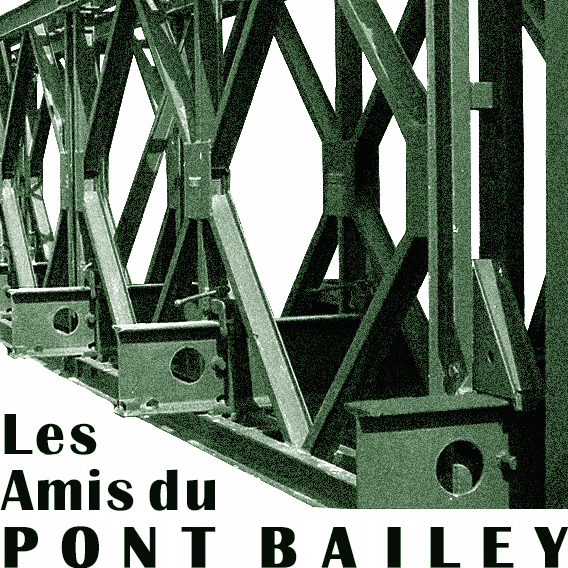 29-09-2008 By the 27th September, a large number of generous friends and supporters had already sponsored all the 110 planks necessary (at €10 each) to re-deck the bridge. This was an extraordinarily rapid response to an appeal launched only 10 days earlier. Following a last-minute change to specifications we decided to support the entire structure on 16 large oak blocks (four at each corner), rather than railway sleepers. Individuals or couples are urgently needed to sponsor these before the Royal Engineers arrive on 5th October to begin the work of rebuilding the bridge on the river Vire, near the centre of Pont-Farcy (see appeal page).
29-09-2008 By the 27th September, a large number of generous friends and supporters had already sponsored all the 110 planks necessary (at €10 each) to re-deck the bridge. This was an extraordinarily rapid response to an appeal launched only 10 days earlier. Following a last-minute change to specifications we decided to support the entire structure on 16 large oak blocks (four at each corner), rather than railway sleepers. Individuals or couples are urgently needed to sponsor these before the Royal Engineers arrive on 5th October to begin the work of rebuilding the bridge on the river Vire, near the centre of Pont-Farcy (see appeal page).
-
 On 17-09-2008 An appeal was launched to raise funds for new decking ('chesses') to replace the rotten timbers that serve as the roadway on the bridge. Supporters were asked to sponsor one plank each (for €10) which will be numbered and identifiable as theirs when the bridge is complete. Membership of Les Amis du Pont Bailey would be automatic. We said we needed 110 planks (400 cm x 22 cm x 4 cm in Douglas fir) and that if the appeal was over-subscribed their donations would go the railway sleeper fund (to provide wheelchair access) but that donors would in any case become members of the association. Amazingly, within 10 days, all 110 of these planks had been sponsored by generous supporters in Normandy and worldwide.
On 17-09-2008 An appeal was launched to raise funds for new decking ('chesses') to replace the rotten timbers that serve as the roadway on the bridge. Supporters were asked to sponsor one plank each (for €10) which will be numbered and identifiable as theirs when the bridge is complete. Membership of Les Amis du Pont Bailey would be automatic. We said we needed 110 planks (400 cm x 22 cm x 4 cm in Douglas fir) and that if the appeal was over-subscribed their donations would go the railway sleeper fund (to provide wheelchair access) but that donors would in any case become members of the association. Amazingly, within 10 days, all 110 of these planks had been sponsored by generous supporters in Normandy and worldwide.
-
 On 11-09-2008 The DDE (Manche) informed Les Amis du Pont Bailey that the bridge would be freely granted to the association (APB) in order to preserve it in perpetuity. This decision was reached in discussions with the Préfecture (Manche) and came as a vast relief to us all since it assures the survival of the last physical evidence of the Battle of Normandy during WWll. Re-positioned near Pont-Farcy, the bridge will henceforth be:
On 11-09-2008 The DDE (Manche) informed Les Amis du Pont Bailey that the bridge would be freely granted to the association (APB) in order to preserve it in perpetuity. This decision was reached in discussions with the Préfecture (Manche) and came as a vast relief to us all since it assures the survival of the last physical evidence of the Battle of Normandy during WWll. Re-positioned near Pont-Farcy, the bridge will henceforth be:
 "A memorial for the Corps of the Royal Engineers; a reminder of the courage and sacrifice of British, American and Canadian troops during the greatest battle in western Europe during the greatest war of all time; and a symbol of thanks to those of all nations who risked their lives or liberty for freedom in France and Europe in WWll."
"A memorial for the Corps of the Royal Engineers; a reminder of the courage and sacrifice of British, American and Canadian troops during the greatest battle in western Europe during the greatest war of all time; and a symbol of thanks to those of all nations who risked their lives or liberty for freedom in France and Europe in WWll."
 On the same day the commander of the Royal Engineers Combat Training Battalion, Col. Graham Gibbs, said that this decision meant that he could now confirm that his men would arrive on October 5th to begin the work of dismantling the bridge and moving it to its new permanent home on the banks of the river Vire at Pont-Farcy.
On the same day the commander of the Royal Engineers Combat Training Battalion, Col. Graham Gibbs, said that this decision meant that he could now confirm that his men would arrive on October 5th to begin the work of dismantling the bridge and moving it to its new permanent home on the banks of the river Vire at Pont-Farcy.
-
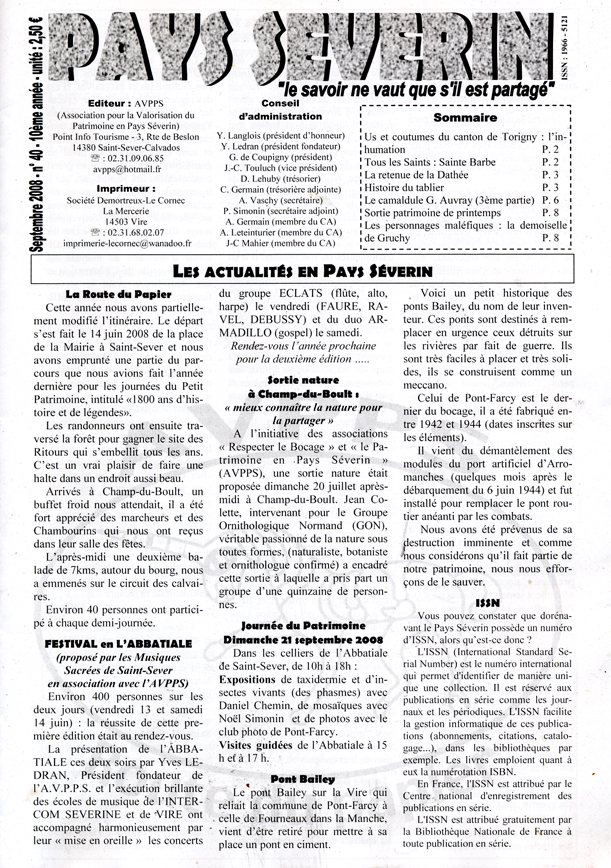 On 04-09-2008 Three members of the Royal Engineers (Capt. Ian Higginbotham, QMSI Scott Jinks and SSgt Neil Viveash) made a 36-hour reconnaissance visit to the Bailey bridge to make detailed plans for the work and logistics involved. Capt. Higginbotham met the mayor of Pont-Farcy who confirmed that the bridge could be positioned in the picnic area on the chemin de halage on the Pleines-Oeuvres side of the river Vire. He also confirmed that the Pont-Farcy camp site would be made available to the 20-25 soldiers in their group for 10 days in October. They then met Monsieur Gerard and Monsieur Daval of the DDE who hoped to be able to give them an official and positive decision from the Préfet within the next week. On the same day Graham Hughes, an engineer from Villebaudon, Manche, kindly offered to become the technical advisor to Les Amis du Pont Bailey, ably assisted two days later day by ex-Royal Marine John Hooper. A decision was also made to limit the length of the bridge to 6 sections (60 ft) rather than the original 9 sections.
On 04-09-2008 Three members of the Royal Engineers (Capt. Ian Higginbotham, QMSI Scott Jinks and SSgt Neil Viveash) made a 36-hour reconnaissance visit to the Bailey bridge to make detailed plans for the work and logistics involved. Capt. Higginbotham met the mayor of Pont-Farcy who confirmed that the bridge could be positioned in the picnic area on the chemin de halage on the Pleines-Oeuvres side of the river Vire. He also confirmed that the Pont-Farcy camp site would be made available to the 20-25 soldiers in their group for 10 days in October. They then met Monsieur Gerard and Monsieur Daval of the DDE who hoped to be able to give them an official and positive decision from the Préfet within the next week. On the same day Graham Hughes, an engineer from Villebaudon, Manche, kindly offered to become the technical advisor to Les Amis du Pont Bailey, ably assisted two days later day by ex-Royal Marine John Hooper. A decision was also made to limit the length of the bridge to 6 sections (60 ft) rather than the original 9 sections.
[See Graham Hughes' Bailey Bridge Inventory 15-09-08]
-
 On 01-09-2008 an article in the magazine Rendezvous appeared throughout Basse-Normandie, explaining to English language readers the campaign to preserve the bridge. The text was almost entirely derived from this web page.
On 01-09-2008 an article in the magazine Rendezvous appeared throughout Basse-Normandie, explaining to English language readers the campaign to preserve the bridge. The text was almost entirely derived from this web page.
- On 16-08-2008 an article in Ouest-France by Liliane Val reported that Les Amis du Pont Bailey were still awaiting two decisions before firm plans could be made with Britain's Royal Engineers regarding their offer to cross the Channel and remove the bridge to a new, permanent location in Pont-Farcy.
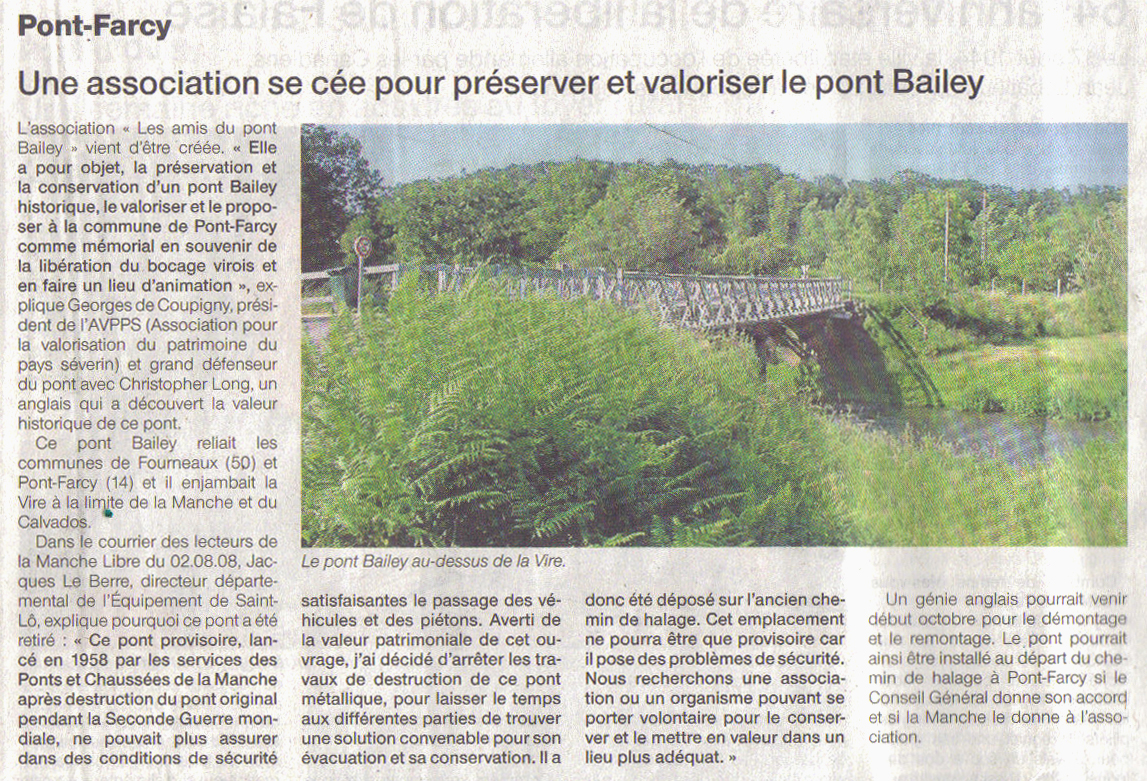 The decisions (delayed because most of France was on holiday throughout August) concerned: (a) whether the Préfet (Manche) would be willing to find the funds to reimburse the bridge contractors and then grant the bridge to the association; and (b) whether the Conseil Général (Calvados) would grant permission (backed by the local commune) for the bridge to be re-built on land beside the former port at Pont-Farcy.
The decisions (delayed because most of France was on holiday throughout August) concerned: (a) whether the Préfet (Manche) would be willing to find the funds to reimburse the bridge contractors and then grant the bridge to the association; and (b) whether the Conseil Général (Calvados) would grant permission (backed by the local commune) for the bridge to be re-built on land beside the former port at Pont-Farcy.
-
 On 09-08-2008 Christophe Lecuyer of the radio station Vire FM broadcast a follow-up news item (based on an interview with Georges de Coupigny) on the campaign to preserve the bridge, covering the formation of Les Amis du Pont Bailey and the offer of help by the Royal Engineers.
On 09-08-2008 Christophe Lecuyer of the radio station Vire FM broadcast a follow-up news item (based on an interview with Georges de Coupigny) on the campaign to preserve the bridge, covering the formation of Les Amis du Pont Bailey and the offer of help by the Royal Engineers.
-
 On 02-08-2008 in a letter to La Manche Libre, Monsieur J. Le Berre, director the DDE (Saint Lô) repeated earlier assurances that his department was seeking ways to secure the future of the bridge by offering it to an association which would preserve it. His letter was in response to the article in the same paper by David Nicolas – "Un pont trop vieux" (see below).
On 02-08-2008 in a letter to La Manche Libre, Monsieur J. Le Berre, director the DDE (Saint Lô) repeated earlier assurances that his department was seeking ways to secure the future of the bridge by offering it to an association which would preserve it. His letter was in response to the article in the same paper by David Nicolas – "Un pont trop vieux" (see below).
-
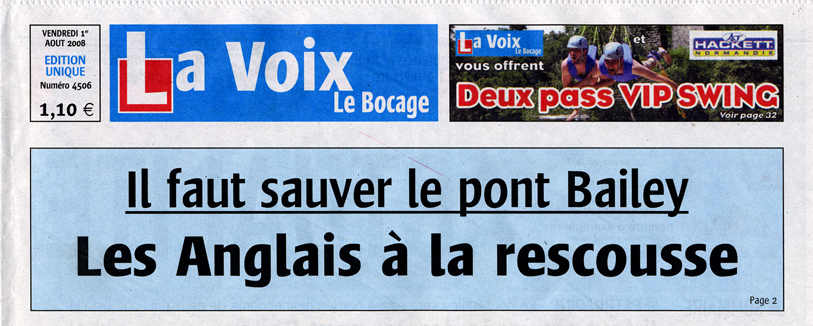 On 01-08-2008 the lead article in La Voix Le Bocage by Laetitia Lemaire announced the proposed arrival on exercise of about 20 soldiers from Britain's Royal Engineers Combat Training School in October 2008. The article, based on an interview with the mayor of Pont-Farcy Alain Deguette, Georges de Coupigny and Christopher & Sarah Long describes how the soldiers plan to dismantle the Fourneaux Bailey bridge and rebuild it in the heart of Pont-Farcy where it will serve the entire community as a form of stage for events of all sorts.
On 01-08-2008 the lead article in La Voix Le Bocage by Laetitia Lemaire announced the proposed arrival on exercise of about 20 soldiers from Britain's Royal Engineers Combat Training School in October 2008. The article, based on an interview with the mayor of Pont-Farcy Alain Deguette, Georges de Coupigny and Christopher & Sarah Long describes how the soldiers plan to dismantle the Fourneaux Bailey bridge and rebuild it in the heart of Pont-Farcy where it will serve the entire community as a form of stage for events of all sorts.
-
 On 28-07-2008 the association les 'Amis du Pont Bailey' [APB] was registered at the sous-préfecture in Vire. The committee currently consists of four administrative officers and four honorary councillors (a fifth honorary councillor will be appointed in due course).
On 28-07-2008 the association les 'Amis du Pont Bailey' [APB] was registered at the sous-préfecture in Vire. The committee currently consists of four administrative officers and four honorary councillors (a fifth honorary councillor will be appointed in due course).
- Christopher Long Founding President
- Georges de Coupigny Vice President
- Pierre Desjardins Secretary
- Sarah Long Treasurer
- Graham Hughes Technical Adviser
- The Mayor of Pont-Farcy Honorary Councillor
- The Commanding Officer, Royal Engineers Combat Engineering School Honorary Councillor
- Jacky Brionne Honorary Councillor
- David Nicolas-Méry Honorary Councillor
- On 28-07-2008 the mayor of Pont-Farcy, Alain Deguette, made a site visit to the picnic area on the east side of the former 'port' of Pont-Farcy with Georges de Coupigny and Christopher Long. Here we were able to identify together the ideal new location for the Fourneaux Bailey bridge on solid ground in a prime position where it could most usefully serve the needs of the local community, with convenient access from the canal tow path as well as good parking nearby. Alain Deguette had already been in contact with the conseil général but agreed to pursue the question of permission to locate the bridge on this site. The bridge could be rebuilt on almost flat land with a firm foundation (the former quay) without causing any damage to existing facilities.
-
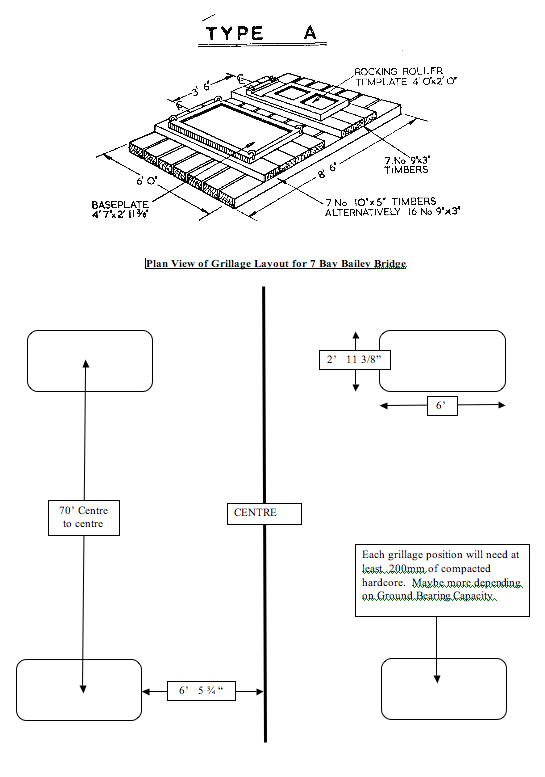 On 25-07-2008 Capt. Andy Cooney RE provided detailed specifications for the footings that would need to be prepared, before the end of September 2008, so that the Bailey bridge could be safely and satisfactorily re-assembled at its final resting place. His specifications require the use of 14 railway sleepers (traverses de chemin de fer) or their adapted equivalents, at each of the four corners, measuring: 7 timbers of 259cm x 25.4cm x 12.7cm and, above them, 7 timbers of 182cm x 22.9cm x 7.6cm. These footings, set precisely square would need to be seated on compacted rubble to a depth of at least 20cm ((see diagram right for details...). The finished bridge would be about 21 metres long by rather less then 6 metres wide. And while the original bridge was 9 sections long (about 27 metres), the new bridge would be 7 sections long (about 21 metres), allowing for two sections to be used for spares/repairs in the future.
On 25-07-2008 Capt. Andy Cooney RE provided detailed specifications for the footings that would need to be prepared, before the end of September 2008, so that the Bailey bridge could be safely and satisfactorily re-assembled at its final resting place. His specifications require the use of 14 railway sleepers (traverses de chemin de fer) or their adapted equivalents, at each of the four corners, measuring: 7 timbers of 259cm x 25.4cm x 12.7cm and, above them, 7 timbers of 182cm x 22.9cm x 7.6cm. These footings, set precisely square would need to be seated on compacted rubble to a depth of at least 20cm ((see diagram right for details...). The finished bridge would be about 21 metres long by rather less then 6 metres wide. And while the original bridge was 9 sections long (about 27 metres), the new bridge would be 7 sections long (about 21 metres), allowing for two sections to be used for spares/repairs in the future.
- On 24-07-2008 Col. Graham Gibbs RE, commander of Britain's Royal Engineers Combat Engineering School, announced that he was offering a detachment of his men to come to Normandy to help us preserve the August 1944 Fourneaux Bailey bridge. Around 20 of his officers and men are expected to arrive at Pont-Farcy on 5 October 2008. Over a period of about ten days they intend to dismantle the bridge, transport it to a new location on the water-front at Pont-Farcy and re-assemble it for permanent presentation. His offer has been accepted with enormous gratitude and relief since it is hard to see how the bridge would have been saved otherwise. We offer our thanks also to Lt. Col. Sean Naile, Maj. Ian Moore, Capt. Andrew Cooney and Capt. Robert Stork whose constant support and enthusiasm led Col. Gibbs to make this generous offer of help.
-
 On 23-07-2008 Alain Deguette (maire de Pont-Farcy) visited the author to say that he would now be happy if the Bailey bridge were to be rebuilt on the picnic area on the eastern side of the river Vire, beside the old port of Pont-Farcy and that he would, of course, immediately contact the local regional councillor, Yves Rondel, to obtain permission from the Conseil Général (Calvados). He also said that he was sure British troops could be given access to the camp site at Pont-Farcy should they be willing to help move the bridge, while a limited budget might be made available to help prepare the ground and footings in preparation for the bridge.
On 23-07-2008 Alain Deguette (maire de Pont-Farcy) visited the author to say that he would now be happy if the Bailey bridge were to be rebuilt on the picnic area on the eastern side of the river Vire, beside the old port of Pont-Farcy and that he would, of course, immediately contact the local regional councillor, Yves Rondel, to obtain permission from the Conseil Général (Calvados). He also said that he was sure British troops could be given access to the camp site at Pont-Farcy should they be willing to help move the bridge, while a limited budget might be made available to help prepare the ground and footings in preparation for the bridge.
- On 19-07-2008 Lt. Col. Sean Naile and Capt. Robert Stork of the Royal Engineers Combat Engineering School, England, visited the author and his wife Sarah Long at Pont-Farcy in order to study the Fourneaux Bailey bridge and assess its suitability as an exercise for newly trained 'sappers'. Their conclusion appeared to be that dismantling, transporting and re-assembling the bridge would provide an excellent opportunity for officers and men of their regiment to practise their Bailey bridge skills while simultaneously leaving a significant memorial to their forebears who had laid the bridge at Arromanches and later during the Battle of Normandy in 1944.
- On 17-07-2008 the author had a site meeting alone with Monsieur Haentjens, director of the bridge contractors 'Entreprise Torres et Vilault' (ETV). Monsieur Haentjens said that whilst he had a responsibility to fulfil his company's obligations with regard to its contract with the DDE (Manche) he nevertheless agreed that it would be sad if the bridge were to be cut up and sold off as scrap and that he hoped it would survive so that future generations would have a monument to the history of France and its liberation by the Allies in WWll. He undertook to discuss all this with the DDE (Didier Gerrard and Jean-Paul Daval) at their next meeting. Monsieur Haentjens also said that he was aware that his company had been responsible for dismantling the original Pegasus Bridge at Caen, for presentation at a museum, and that his company had been responsible for buildling a replica of Pegasus Bridge on the original site.
-
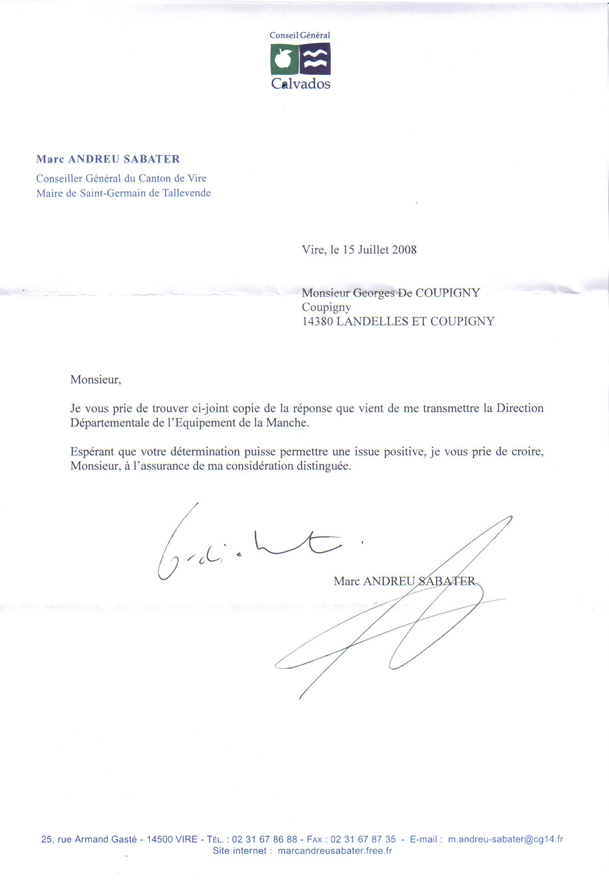
 On 15-07-2008 Marc Andreu Sabater (conseiller général, Vire) wrote to say that he had been assured by the DDE of a moratorium period giving us time to propose solutions for its preservation and offering us his support.
On 15-07-2008 Marc Andreu Sabater (conseiller général, Vire) wrote to say that he had been assured by the DDE of a moratorium period giving us time to propose solutions for its preservation and offering us his support.
Local MP Jean-Yves Cousin (député, Vire) had apparently received a similar undertaking by the DDE.
- By 10-07-2008 a number of supporters had taken the trouble to offer help and encouragement. They included: Guillaume Bourrel; photo-journalist Jean Delafontaine (who supplied some of the images on this page); Alain Cavaillé; Yves Hermon (mayor of Fourneaux); Michel 'Moloch' Clatigny (cartoonist); Colin King; Nicole Collette; Patrick Claeys (a Belgian Bailey bridge expert); and Derek Flippance a Bailey bridge specialist at the Royal Engineers Museum, England.; and many others...
- On 08-07-2008 the author wrote to Capt. Andrew Cooney of the Royal Engineers Combat Engineering School asking for his regiment's help in saving a bridge that was the last physical evidence resulting from the British engagement in the Battle of Normandy in the bocage – other than Pegasus Bridge and the artificial harbour at Arromanches. Capt. Cooney's response was immediately positive though, understandably, he could make no immediate promises of support. A long-running correspondence with Capt. Cooney and his fellow officers then ensued.
- On 07-07-2008 our friend Roger Stanton (secretary of ELMS, England) suggested he would contact the Royal Engineers to see whether they would be prepared to help save a bridge laid by their WWll 'forebears'. This turned out to be an invaluable contribution, along with a wide range of other useful suggestions and background information.
-
 On 07-07-2008 Christophe Lecuyer of the radio station Vire FM broadcast an interview with Christopher Long and Georges de Coupigny (recorded 04-07-08) in which they outlined their campaign to preserve the bridge as a legacy to future generations and a monument to those who built it and who used it to win the Battle of Normandy and the Liberation of France in WWll.
On 07-07-2008 Christophe Lecuyer of the radio station Vire FM broadcast an interview with Christopher Long and Georges de Coupigny (recorded 04-07-08) in which they outlined their campaign to preserve the bridge as a legacy to future generations and a monument to those who built it and who used it to win the Battle of Normandy and the Liberation of France in WWll.
-
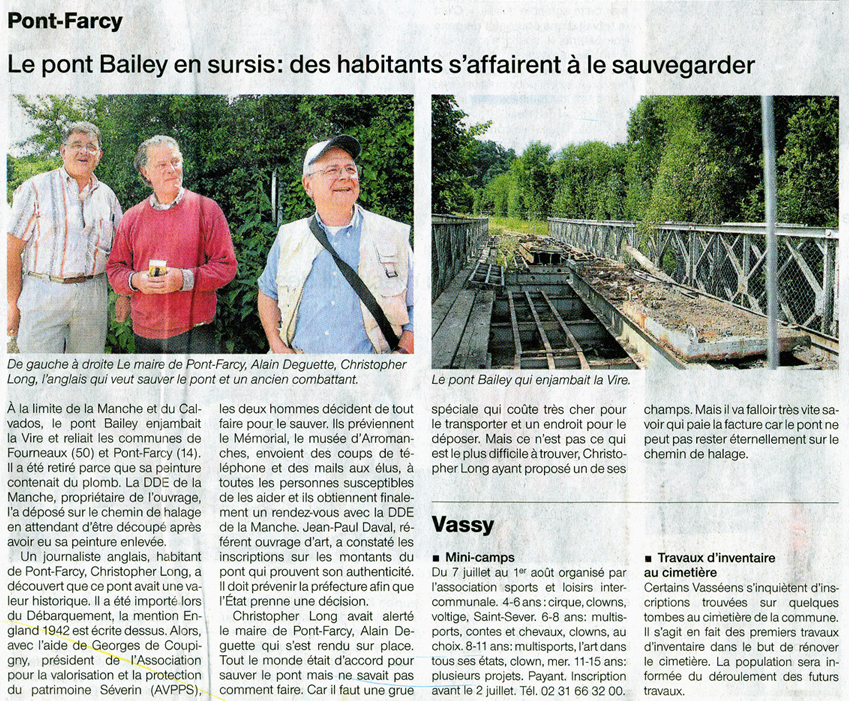 On 01-07-2008 Ouest-France carried an illustrated article explaining our campaign to preserve the bridge.
On 01-07-2008 Ouest-France carried an illustrated article explaining our campaign to preserve the bridge.
- On 30-06-2008 a second site meeting took place consisting of the author, Jean-Paul Daval (DDE), Yves Hermon (mayor of Fourneaux), Alain Deguette (mayor of Pont-Farcy), and Pierre Desjardins (ancien combattant). At this meeting it was made clear that the Bailey bridge was the property of the Préfecture de la Manche (representing the State which had inherited all equipment dating from WWll). We were also told that the Préfecture was prepared to offer the bridge as a gift to a non-profit 'association' (loi 1901) i.e. 'Les Amis du Pont Bailey' provided that: 1. Any financial obligations to the contractors had been settled; 2. That the bridge would be dismantled and removed to a suitable site within a defined time limit; 3. That the bridge would be reassembled elsewhere for public display on condition that it was not to be used as a 'bridge' (for legal reasons as a matter of public safety).
-
 On 27-06-2008 our friend David Nicolas-Méry (historian, curator and archaeologist) wrote an excellent illustrated article in La Manche Libre extolling the virtues of Bailey bridges in WWll and the importance of saving this last vestige of Britain's contribution to the Battle of Normandy in the bocage.
On 27-06-2008 our friend David Nicolas-Méry (historian, curator and archaeologist) wrote an excellent illustrated article in La Manche Libre extolling the virtues of Bailey bridges in WWll and the importance of saving this last vestige of Britain's contribution to the Battle of Normandy in the bocage.
-
 On 27-06-2008 Isabelle Innocenti, editor in chief of La Voix le Bocage, wrote an excellent article based on the site meeting with the DDE and the contractors on 23 June.
On 27-06-2008 Isabelle Innocenti, editor in chief of La Voix le Bocage, wrote an excellent article based on the site meeting with the DDE and the contractors on 23 June.
-
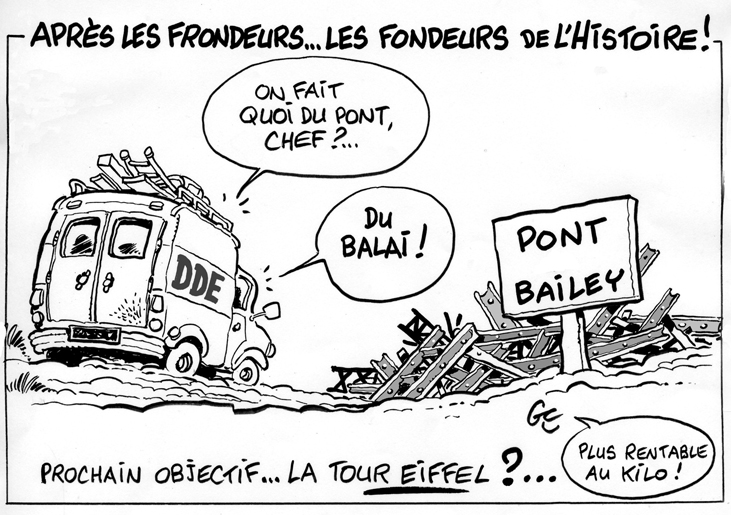 On 26-06-2007 the celebrated cartoonist Gérard 'Gégé' Cousseau produced a delightful drawing that cheered us all up.
On 26-06-2007 the celebrated cartoonist Gérard 'Gégé' Cousseau produced a delightful drawing that cheered us all up.
But it has to be said that the DDE (notably Jean-Paul Daval and Didier Gerard) had been among our most helpful supporters from the moment they learned that their old iron bridge was indeed a Bailey bridge!
-
 On 23-06-2008 a site meeting took place at which the author and Georges de Coupigny met Jean-Paul Daval and his colleague Jean-Pierre Masson of the DDE (Manche) who were managing the bridging project. We were accompanied by Isabelle Innocenti of La Voix le Bocage, Liliane Val of La Manche Libre, Alain Deguette mayor of Pont-Farcy, Pierre Desjardins (ancien combattant) and Guillaume Stephan of the contractors ETV. The author was able to prove that this was indeed an historic WWll Bailey bridge – a fact the DDE was unaware of since its origins had not been recorded in their files. We are immensely grateful to Jean-Paul Daval (and his colleague Didier Gerrard) who was immediately sympathetic with our campaign and who has consistently offered invaluable support thereafter.
On 23-06-2008 a site meeting took place at which the author and Georges de Coupigny met Jean-Paul Daval and his colleague Jean-Pierre Masson of the DDE (Manche) who were managing the bridging project. We were accompanied by Isabelle Innocenti of La Voix le Bocage, Liliane Val of La Manche Libre, Alain Deguette mayor of Pont-Farcy, Pierre Desjardins (ancien combattant) and Guillaume Stephan of the contractors ETV. The author was able to prove that this was indeed an historic WWll Bailey bridge – a fact the DDE was unaware of since its origins had not been recorded in their files. We are immensely grateful to Jean-Paul Daval (and his colleague Didier Gerrard) who was immediately sympathetic with our campaign and who has consistently offered invaluable support thereafter.
-
 On 20-06-2008 Laetitia Lemaire of La Voix le Bocage wrote a very helpful article explaining the risk that this historic bridge might be lost and the campaign to save it, illustrated with photographs of the bridge before it had been removed.
On 20-06-2008 Laetitia Lemaire of La Voix le Bocage wrote a very helpful article explaining the risk that this historic bridge might be lost and the campaign to save it, illustrated with photographs of the bridge before it had been removed.
-
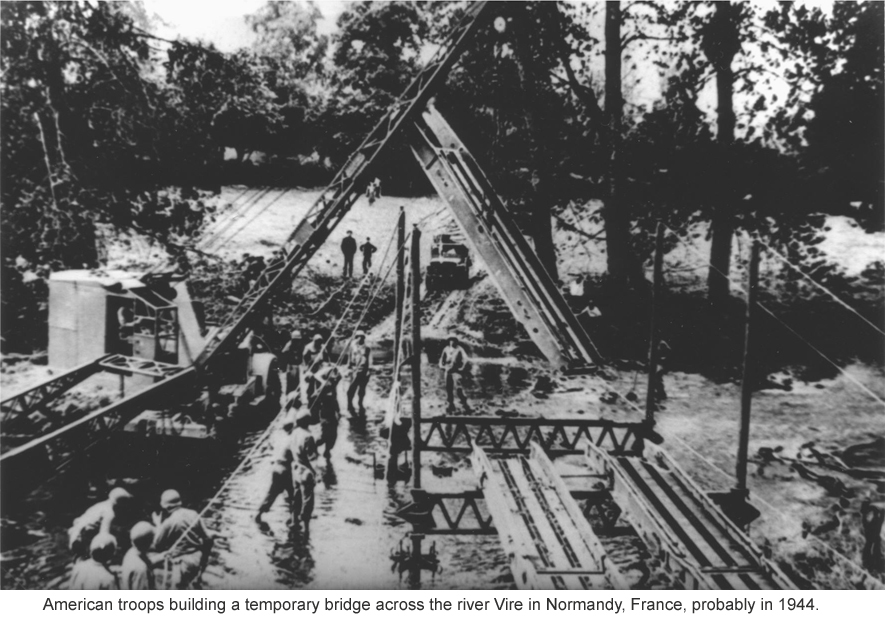 On 18-06-2008 Thanks to our friend Jacky Brionne, a local historian and a senior archivist at the Archives de St Lô, we were put us in touch with the managers of the Manche DDE (engineering department) responsible for the bridging project and the Manche Préfecture was alerted. The same evening DDE director Jacques Le Berre ordered that the bridge was to be given a stay of execution pending investigations and said that the contractors ETV had been notified.
On 18-06-2008 Thanks to our friend Jacky Brionne, a local historian and a senior archivist at the Archives de St Lô, we were put us in touch with the managers of the Manche DDE (engineering department) responsible for the bridging project and the Manche Préfecture was alerted. The same evening DDE director Jacques Le Berre ordered that the bridge was to be given a stay of execution pending investigations and said that the contractors ETV had been notified.
-
 On 17-06-2008 The author, Christopher Long noted by chance that his much-loved Fourneaux Bailey bridge, a veteran of the Battle of Normandy and which had long spanned the River Vire between Pont-Farcy and Tessy-sur-Vire, had been removed to make way for a new bridge. On 9 June 2008 a large crane had dumped it on the nearby tow-path where workmen said that it was to be cut up and sold for scrap. They said that it was only because of its layers of lead-based paint that it had survived intact because cutting it up would have contaminated the river.
On 17-06-2008 The author, Christopher Long noted by chance that his much-loved Fourneaux Bailey bridge, a veteran of the Battle of Normandy and which had long spanned the River Vire between Pont-Farcy and Tessy-sur-Vire, had been removed to make way for a new bridge. On 9 June 2008 a large crane had dumped it on the nearby tow-path where workmen said that it was to be cut up and sold for scrap. They said that it was only because of its layers of lead-based paint that it had survived intact because cutting it up would have contaminated the river.
 The author immediately sought help from his old friend Georges de Coupigny, president of the AVPPS and together they decided to launch a campaign to preserve the bridge for posterity. They wrote a letter to the Mémorial de Caen WWll museum whose director Stéphane Grimaldi replied two weeks later saying that he could not help. A similar appeal to the Arromanches D-Day Museum produced no response at all. Fortunately dozens of people came forward to support the campaign, thus leading to the foundation of Les Amis du Pont Bailey. But it must be said that without the support and enthusiasm of the author's wife, Sarah Long, nothing would have happened, nobody would have been fed and watered... and the bridge would have been lost before the fight could begin...
The author immediately sought help from his old friend Georges de Coupigny, president of the AVPPS and together they decided to launch a campaign to preserve the bridge for posterity. They wrote a letter to the Mémorial de Caen WWll museum whose director Stéphane Grimaldi replied two weeks later saying that he could not help. A similar appeal to the Arromanches D-Day Museum produced no response at all. Fortunately dozens of people came forward to support the campaign, thus leading to the foundation of Les Amis du Pont Bailey. But it must be said that without the support and enthusiasm of the author's wife, Sarah Long, nothing would have happened, nobody would have been fed and watered... and the bridge would have been lost before the fight could begin...

 Pictured right: Press cuttings from Ouest-France in February 1990 and February 2001. These pictures show the extraordinary flooding of the Vire valley through Pont-Farcy in 1990 which damaged the footings of the bridge at La Grippe. This 'bridge' was in fact formed from a rare surviving 'Whale' element of the 1944 Mulberry B artificial harbour from Arromanches. Unrecognised by the local council as an historic monument, it was dismantled. However, thanks to the good sense of the contractor involved, it was not destroyed and its whereabouts were known in 2008.
Pictured right: Press cuttings from Ouest-France in February 1990 and February 2001. These pictures show the extraordinary flooding of the Vire valley through Pont-Farcy in 1990 which damaged the footings of the bridge at La Grippe. This 'bridge' was in fact formed from a rare surviving 'Whale' element of the 1944 Mulberry B artificial harbour from Arromanches. Unrecognised by the local council as an historic monument, it was dismantled. However, thanks to the good sense of the contractor involved, it was not destroyed and its whereabouts were known in 2008.
 About 10 years later a genuine WWll Bailey bridge had replaced Mulberry Harbour 'Whale' bridge at La Grippe in order to allow construction of the adjacent motorway. But by 2001 the historic value of this Bailey bridge was again not recognised by the local authority. It was regarded simply as a 'post-war metallic bridge'. Although the then mayor, Claude Hue, did his best to retain it, simply because a bridge of any sort was needed to link Pont-Farcy with Pleines-Œuvres at La Grippe, the town failed to negotiate a successful solution with the Calvados DDE. The bridge was dismantled and its whereabouts are unknown. Today there is no means of crossing the Vire to Pleines-Œuvres at La Grippe.
About 10 years later a genuine WWll Bailey bridge had replaced Mulberry Harbour 'Whale' bridge at La Grippe in order to allow construction of the adjacent motorway. But by 2001 the historic value of this Bailey bridge was again not recognised by the local authority. It was regarded simply as a 'post-war metallic bridge'. Although the then mayor, Claude Hue, did his best to retain it, simply because a bridge of any sort was needed to link Pont-Farcy with Pleines-Œuvres at La Grippe, the town failed to negotiate a successful solution with the Calvados DDE. The bridge was dismantled and its whereabouts are unknown. Today there is no means of crossing the Vire to Pleines-Œuvres at La Grippe.
A Bailey bridge is composed of 'sections' and the steelwork in one section weighs 1,910 kg. With its timber chesses (planking) and two timber 'ribands' (side protectors) a complete section weighs more than 2 tonnes.
Galleries of images taken by various members
of Les Amis du Pont Bailey in October 2008.
Bailey Bridge — 17-06-08 — Dumped
Bailey Bridge — 06-10-08 — Dismantling
Bailey Bridge — 08-10-08 — Terracing
Bailey Bridge — 10-10-08 — Transporting
Bailey Bridge — 11-10-08 — Rebuilding
Bailey Bridge — 14-10-08 — Painting
Bailey Bridge — 15-10-08 — Decking
Bailey Bridge — 16-10-08 — Completed
Bailey Bridge — 17-10-08 — Opening Ceremony
Bailey Bridge — 17-10-08 — Aftermath
Bailey Bridge — 17-10-08 — Unused Parts
Bailey Bridge — 08-08-09 — Inauguration
© (2008) Christopher A. Long. Copyright, Syndication & All Rights Reserved Worldwide.
The text and graphical content of this and linked documents are the copyright of their author and or creator and site designer, Christopher Long, unless otherwise stated. No publication, reproduction or exploitation of this material may be made in any form prior to clear written agreement of terms with the author or his agents.
















